Flying Nun Records/Dunedin Sound - Indie Pop MADE IN NEW ZEALAND
+23
John volcanoes
uno cualquiera
JFG
Gran Mimón
Francois Zappa
getyaya
esquío
melon head
kilgore trout
Boohan
Bokor
morley
CountryJoe
crancranc
Dust N Bones !?
Rockin' Yakuza
cracote
andricsos
Neska
DeGuindos al Pavo
luis
deniztek
Peaky Blinder
27 participantes
Página 6 de 11.
Página 6 de 11. •  1, 2, 3 ... 5, 6, 7 ... 9, 10, 11
1, 2, 3 ... 5, 6, 7 ... 9, 10, 11 
 Re: Flying Nun Records/Dunedin Sound - Indie Pop MADE IN NEW ZEALAND
Re: Flying Nun Records/Dunedin Sound - Indie Pop MADE IN NEW ZEALAND
m b v escribió:Para variar un poco, también voy a incluir algo de música neozelandesa no relacionada con el indie pop tan característico. En este caso, algo de punk ochentero.
Y aquí una de las mejores bandas punk de todo el hemisferio sur, una de esas joyas que recién vi que se mencionó en alguna página de esas tipo playground. Señoras y señores, desde Auckland, Nueva Zelanda, The Scavengers.
PS:
Mítico Ak79 varios. De esa época, el split entre Proud Scum y Terrorways merece mucho la pena.
Y bueno, The Enemy (siempre me he preguntado si habrá material como tal) y los posteriores Toy Love... favoritos. Pero es que Chris Knox es el más.
Siento insistir, pero es que viene al pelo. De 1980 y la mezcla perfecta entre punk, post punk y dunedin sound...
https://catalinatapes.bandcamp.com/album/c-t-04-features-x-features-lp
kilgore trout- Mensajes : 33
Fecha de inscripción : 10/10/2016
 Re: Flying Nun Records/Dunedin Sound - Indie Pop MADE IN NEW ZEALAND
Re: Flying Nun Records/Dunedin Sound - Indie Pop MADE IN NEW ZEALAND
Quise postearlo en diciembre, pero me he acordado justo ahora. Traigo una golosina golosa golosa que gustará a más de uno:
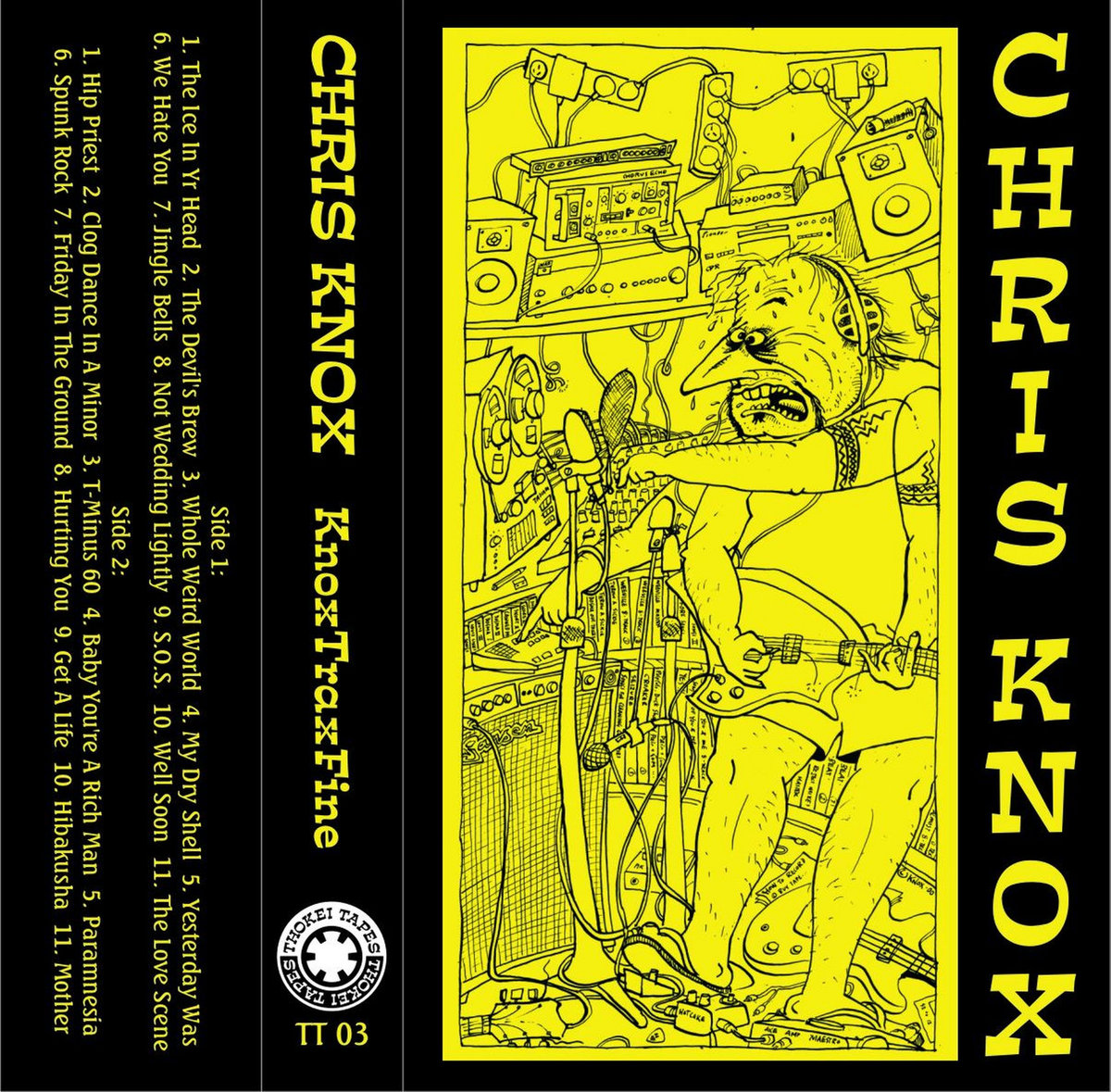
Resulta que, aunque Chris Knox vaya a quedar inválido de por vida, y que su último disco en solitario date del año 2000, "Beat", -aunque en realidad fue en 2008 con bajo el título "Chris Knox and The Nothing" con el disco "A Warm Gun"-, el año pasado volvió a sacar un disco a la venta. Sí, desgraciadamente no ha recuperado el habla, ni tiene pinta que lo vaya a hacer, pero al menos el año pasado salió al mercado a disposición de todos "KnoxTraxFine", una compilación de rarezas inéditas nunca antes escuchadas por el público.
Han pasado ya 8 años desde que este auténtico genio no reconocido sufriera un infarto que le ha dejado con el lado derecho del cuerpo paralizado y sin habla (apenas es capaz de decir unas 20 palabras). Durante este tiempo ha sido en gran medida un hombre de gran voluntad, a pesar de no poder hablar más allá de unas pocas palabras (entiende a los visitantes y amigos razonablemente bien), y ha aprendido a pintar con la mano izquierda. Ha actuado unas pocas veces en los últimos años (y grabado una canción con el grupo de Auckland "Rackets").
KnoxTraxFine es una especie de disco compilatorio, la mayoría de las canciones fueron lanzadas en varias compilaciones entre 1987-2004, pero por primera vez, estas canciones (algunas de ellas muy difíciles de encontrar) se encuentran en este único disco. Todo esto ha sido posible gracias a la discográfica independiente "Thokei Tapes", que ha desenterrado un tesoro de 22 canciones de esta leyenda del indie neozelandés que van de lo raro a lo muy raro. Este cassete es lo más parecido a un nuevo álbum doble. Knox ha sido activo e inmensamente inspirador para muchos en varios campos. Trabajando como cineasta experimental, dibujante, escritor de música, crítico, productor y, por supuesto, músico prolífico, fue una de las figuras clave de la incipiente escena musical indie de los años ochenta y crucialmente involucrada en el ascenso de la legendaria Flying Nun Records.
KnoxTraxFine trae todo junto: recopilación, cassette limitado, caras b y otras rarezas, incluyendo una versión alternativa de su éxito de 1989, "Not Given Lightly" o versiones inspiradas de canciones de Abba, The Great Unwashed, Alec Bathgate, The Fall -cuyo tour por Nueva Zelanda en 1982 Knox grabó para Flying Nun - y John Lennon y The Beatles, a quienes admira mucho.
Este cassette es imprescindible incluso para aquellos que tienen una gran selección de discos de Chris Knox y Tall Dwarfs en sus colecciones. Ruidoso y profundamente conmovedor, profundo e ingenioso, estas 22 canciones tienen más de una sorpresa. 1 hora y 16 minutos de maravilla.

- Spoiler:
- https://mega.nz/#!N8sUmbDJ!IYi_6eUXupd6tUWcscN2Rpqq2FrxLkLxP3txQ85qLl8
Resulta que, aunque Chris Knox vaya a quedar inválido de por vida, y que su último disco en solitario date del año 2000, "Beat", -aunque en realidad fue en 2008 con bajo el título "Chris Knox and The Nothing" con el disco "A Warm Gun"-, el año pasado volvió a sacar un disco a la venta. Sí, desgraciadamente no ha recuperado el habla, ni tiene pinta que lo vaya a hacer, pero al menos el año pasado salió al mercado a disposición de todos "KnoxTraxFine", una compilación de rarezas inéditas nunca antes escuchadas por el público.
Han pasado ya 8 años desde que este auténtico genio no reconocido sufriera un infarto que le ha dejado con el lado derecho del cuerpo paralizado y sin habla (apenas es capaz de decir unas 20 palabras). Durante este tiempo ha sido en gran medida un hombre de gran voluntad, a pesar de no poder hablar más allá de unas pocas palabras (entiende a los visitantes y amigos razonablemente bien), y ha aprendido a pintar con la mano izquierda. Ha actuado unas pocas veces en los últimos años (y grabado una canción con el grupo de Auckland "Rackets").
KnoxTraxFine es una especie de disco compilatorio, la mayoría de las canciones fueron lanzadas en varias compilaciones entre 1987-2004, pero por primera vez, estas canciones (algunas de ellas muy difíciles de encontrar) se encuentran en este único disco. Todo esto ha sido posible gracias a la discográfica independiente "Thokei Tapes", que ha desenterrado un tesoro de 22 canciones de esta leyenda del indie neozelandés que van de lo raro a lo muy raro. Este cassete es lo más parecido a un nuevo álbum doble. Knox ha sido activo e inmensamente inspirador para muchos en varios campos. Trabajando como cineasta experimental, dibujante, escritor de música, crítico, productor y, por supuesto, músico prolífico, fue una de las figuras clave de la incipiente escena musical indie de los años ochenta y crucialmente involucrada en el ascenso de la legendaria Flying Nun Records.
KnoxTraxFine trae todo junto: recopilación, cassette limitado, caras b y otras rarezas, incluyendo una versión alternativa de su éxito de 1989, "Not Given Lightly" o versiones inspiradas de canciones de Abba, The Great Unwashed, Alec Bathgate, The Fall -cuyo tour por Nueva Zelanda en 1982 Knox grabó para Flying Nun - y John Lennon y The Beatles, a quienes admira mucho.
Este cassette es imprescindible incluso para aquellos que tienen una gran selección de discos de Chris Knox y Tall Dwarfs en sus colecciones. Ruidoso y profundamente conmovedor, profundo e ingenioso, estas 22 canciones tienen más de una sorpresa. 1 hora y 16 minutos de maravilla.
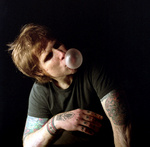
Peaky Blinder- Mensajes : 3453
Fecha de inscripción : 12/03/2010
 Re: Flying Nun Records/Dunedin Sound - Indie Pop MADE IN NEW ZEALAND
Re: Flying Nun Records/Dunedin Sound - Indie Pop MADE IN NEW ZEALAND
Igual esto interesa por aquí, muy buen precio
https://www.amazon.co.uk/Anthology-VINYL-Clean/dp/B00KIFES3W/ref=sr_1_1?ie=UTF8&qid=1490769726
https://www.amazon.co.uk/Anthology-VINYL-Clean/dp/B00KIFES3W/ref=sr_1_1?ie=UTF8&qid=1490769726
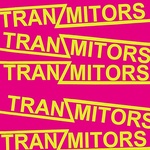
melon head- Mensajes : 14677
Fecha de inscripción : 28/03/2008
 Re: Flying Nun Records/Dunedin Sound - Indie Pop MADE IN NEW ZEALAND
Re: Flying Nun Records/Dunedin Sound - Indie Pop MADE IN NEW ZEALAND
m b v escribió:Quise postearlo en diciembre, pero me he acordado justo ahora. Traigo una golosina golosa golosa que gustará a más de uno:
- Spoiler:
Resulta que, aunque Chris Knox vaya a quedar inválido de por vida, y que su último disco en solitario date del año 2000, "Beat", -aunque en realidad fue en 2008 con bajo el título "Chris Knox and The Nothing" con el disco "A Warm Gun"-, el año pasado volvió a sacar un disco a la venta. Sí, desgraciadamente no ha recuperado el habla, ni tiene pinta que lo vaya a hacer, pero al menos el año pasado salió al mercado a disposición de todos "KnoxTraxFine", una compilación de rarezas inéditas nunca antes escuchadas por el público.
Han pasado ya 8 años desde que este auténtico genio no reconocido sufriera un infarto que le ha dejado con el lado derecho del cuerpo paralizado y sin habla (apenas es capaz de decir unas 20 palabras). Durante este tiempo ha sido en gran medida un hombre de gran voluntad, a pesar de no poder hablar más allá de unas pocas palabras (entiende a los visitantes y amigos razonablemente bien), y ha aprendido a pintar con la mano izquierda. Ha actuado unas pocas veces en los últimos años (y grabado una canción con el grupo de Auckland "Rackets").
KnoxTraxFine es una especie de disco compilatorio, la mayoría de las canciones fueron lanzadas en varias compilaciones entre 1987-2004, pero por primera vez, estas canciones (algunas de ellas muy difíciles de encontrar) se encuentran en este único disco. Todo esto ha sido posible gracias a la discográfica independiente "Thokei Tapes", que ha desenterrado un tesoro de 22 canciones de esta leyenda del indie neozelandés que van de lo raro a lo muy raro. Este cassete es lo más parecido a un nuevo álbum doble. Knox ha sido activo e inmensamente inspirador para muchos en varios campos. Trabajando como cineasta experimental, dibujante, escritor de música, crítico, productor y, por supuesto, músico prolífico, fue una de las figuras clave de la incipiente escena musical indie de los años ochenta y crucialmente involucrada en el ascenso de la legendaria Flying Nun Records.
KnoxTraxFine trae todo junto: recopilación, cassette limitado, caras b y otras rarezas, incluyendo una versión alternativa de su éxito de 1989, "Not Given Lightly" o versiones inspiradas de canciones de Abba, The Great Unwashed, Alec Bathgate, The Fall -cuyo tour por Nueva Zelanda en 1982 Knox grabó para Flying Nun - y John Lennon y The Beatles, a quienes admira mucho.
Este cassette es imprescindible incluso para aquellos que tienen una gran selección de discos de Chris Knox y Tall Dwarfs en sus colecciones. Ruidoso y profundamente conmovedor, profundo e ingenioso, estas 22 canciones tienen más de una sorpresa. 1 hora y 16 minutos de maravilla.
El sello en cuestión va a hacer, para mayo, una nueva tirada bastante limitada. Lanzad un mail ahora que aún estará la lista de preorder disponible.
kilgore trout- Mensajes : 33
Fecha de inscripción : 10/10/2016

Peaky Blinder- Mensajes : 3453
Fecha de inscripción : 12/03/2010
 Re: Flying Nun Records/Dunedin Sound - Indie Pop MADE IN NEW ZEALAND
Re: Flying Nun Records/Dunedin Sound - Indie Pop MADE IN NEW ZEALAND
Mantiene sensacionalmente el tipo el Daddy's Highway de los BATS.. 

 Re: Flying Nun Records/Dunedin Sound - Indie Pop MADE IN NEW ZEALAND
Re: Flying Nun Records/Dunedin Sound - Indie Pop MADE IN NEW ZEALAND
Vamooooooooooooooossss

Peaky Blinder- Mensajes : 3453
Fecha de inscripción : 12/03/2010
 Re: Flying Nun Records/Dunedin Sound - Indie Pop MADE IN NEW ZEALAND
Re: Flying Nun Records/Dunedin Sound - Indie Pop MADE IN NEW ZEALAND
Estaba pensando seriamente crear un blog dedicado a la música neozelandesa, concretamente a la relacionada con este "Dunedin Sound" junto con algo de música kiwi anterior y posterior a este movimiento, con discografías enteras de grupos en descarga directa, pero teniendo en cuenta que apenas lo visitarían cuatro gatos contados... no le veo sentido.
Hay dos blogs para descargar discos de este tipo de música neozelandesa, creo que son los más famosos, o al menos, los que más lo fueron en su momento, ya que en ambos blogs su único periodo de actividad data solo desde 2007 a 2008, cuando empezaban a ser populares los blogs, rapidshare y megaupload. Pero en estos blogs el 95% de los links están caídos.
kiwitapes.blogspot.com
thedoledrums.blogspot.com
Mi intención era crear un nuevo blog posteando información general sobre todos los grupos de esta escena acompañados de fotos y sus respectivas discografías, desde los más conocidos hasta aquellos que no conoce ni el tato y que hoy están más olvidados que la t de tsunami. Ojalá este post y este tipo de música tuviera más repercusión y adeptos por aquí, ya sería razón suficiente para empezar esa pequeña aventura.
Hay dos blogs para descargar discos de este tipo de música neozelandesa, creo que son los más famosos, o al menos, los que más lo fueron en su momento, ya que en ambos blogs su único periodo de actividad data solo desde 2007 a 2008, cuando empezaban a ser populares los blogs, rapidshare y megaupload. Pero en estos blogs el 95% de los links están caídos.
kiwitapes.blogspot.com
thedoledrums.blogspot.com
Mi intención era crear un nuevo blog posteando información general sobre todos los grupos de esta escena acompañados de fotos y sus respectivas discografías, desde los más conocidos hasta aquellos que no conoce ni el tato y que hoy están más olvidados que la t de tsunami. Ojalá este post y este tipo de música tuviera más repercusión y adeptos por aquí, ya sería razón suficiente para empezar esa pequeña aventura.

Peaky Blinder- Mensajes : 3453
Fecha de inscripción : 12/03/2010
 Re: Flying Nun Records/Dunedin Sound - Indie Pop MADE IN NEW ZEALAND
Re: Flying Nun Records/Dunedin Sound - Indie Pop MADE IN NEW ZEALAND
m b v escribió:Estaba pensando seriamente crear un blog dedicado a la música neozelandesa, concretamente a la relacionada con este "Dunedin Sound" junto con algo de música kiwi anterior y posterior a este movimiento, con discografías enteras de grupos en descarga directa, pero teniendo en cuenta que apenas lo visitarían cuatro gatos contados... no le veo sentido.
Hay dos blogs para descargar discos de este tipo de música neozelandesa, creo que son los más famosos, o al menos, los que más lo fueron en su momento, ya que en ambos blogs su único periodo de actividad data solo desde 2007 a 2008, cuando empezaban a ser populares los blogs, rapidshare y megaupload. Pero en estos blogs el 95% de los links están caídos.
kiwitapes.blogspot.com
thedoledrums.blogspot.com
Mi intención era crear un nuevo blog posteando información general sobre todos los grupos de esta escena acompañados de fotos y sus respectivas discografías, desde los más conocidos hasta aquellos que no conoce ni el tato y que hoy están más olvidados que la t de tsunami. Ojalá este post y este tipo de música tuviera más repercusión y adeptos por aquí, ya sería razón suficiente para empezar esa pequeña aventura.
Kiwitapes sí que lo controlaba. Si no me equivoco, llegué allí buscando algo de The Pin Group.
El otro no me suena

crancranc- Mensajes : 35567
Fecha de inscripción : 10/06/2010
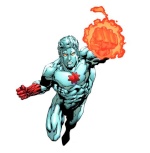
CountryJoe- Mensajes : 11537
Fecha de inscripción : 02/08/2013

CountryJoe- Mensajes : 11537
Fecha de inscripción : 02/08/2013

CountryJoe- Mensajes : 11537
Fecha de inscripción : 02/08/2013

CountryJoe- Mensajes : 11537
Fecha de inscripción : 02/08/2013
 Re: Flying Nun Records/Dunedin Sound - Indie Pop MADE IN NEW ZEALAND
Re: Flying Nun Records/Dunedin Sound - Indie Pop MADE IN NEW ZEALAND
Madre del amor hermoso, qué barbaridad menospreciada llena de gemas preciosas y de valor incalculable es el "Mister Pop", discazo impresionante donde los haya! Ojalá vuelvan a sacar nuevo disco pronto!

Peaky Blinder- Mensajes : 3453
Fecha de inscripción : 12/03/2010
 Re: Flying Nun Records/Dunedin Sound - Indie Pop MADE IN NEW ZEALAND
Re: Flying Nun Records/Dunedin Sound - Indie Pop MADE IN NEW ZEALAND
Pedazo discografía en solitario que tiene David Kilgour, y que nadie conozca a este genio es para hacérselo mirar.
Here Come the Cars (1991)

Sugar Mouth (1994)

Y aquí una entrevista por parte de Ruta66 en exclusiva en español que data de 2011:
https://www.ruta66.es/2012/01/encuentros/david-kilgour-es-solo-rockaroll-iiiexclusiva-web/
Here Come the Cars (1991)

Sugar Mouth (1994)

Y aquí una entrevista por parte de Ruta66 en exclusiva en español que data de 2011:
https://www.ruta66.es/2012/01/encuentros/david-kilgour-es-solo-rockaroll-iiiexclusiva-web/

Peaky Blinder- Mensajes : 3453
Fecha de inscripción : 12/03/2010
 Re: Flying Nun Records/Dunedin Sound - Indie Pop MADE IN NEW ZEALAND
Re: Flying Nun Records/Dunedin Sound - Indie Pop MADE IN NEW ZEALAND
The Clean: Part One 1978 - 1988
“We resented the one way culture traffic into New Zealand…” - The Clean
We were living in the bottom flat of a two-storey concrete block on the east side of the Waikato River in the upper North Island city of Hamilton, my brother Gonzo, the Christian and I. Working and studying and obsessing about our favourite indie bands in a small inky, stencil-cut fanzine called Ha Ha Ha, which we’d drop in record shops in town and send to Ima Hitt in New Plymouth and Flying Nun Records to distribute.
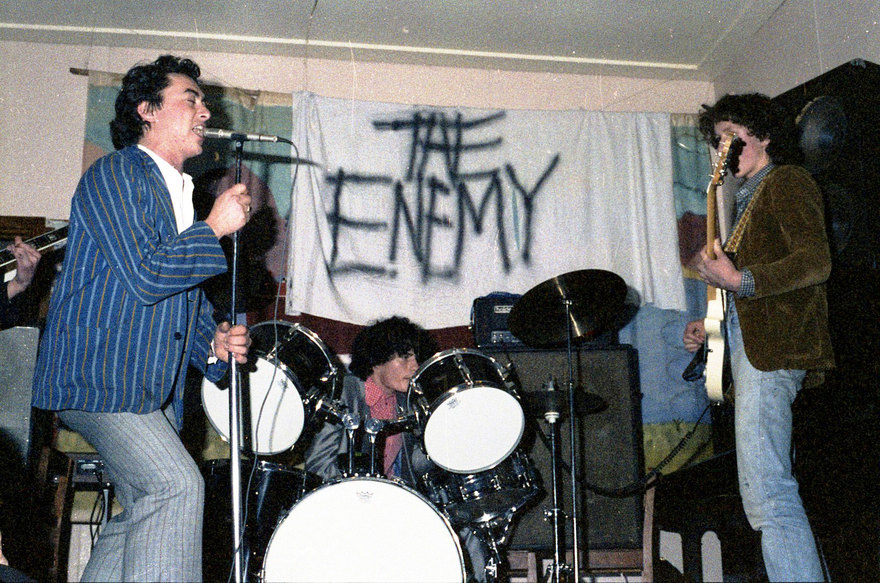
The Clean, 1978, at Beneficiaries Hall, Dunedin. Doug Hood (vocals), David Kilgour (guitar), Peter Gutteridge (bass), Hamish Kilgour (drums) - Photo by Jeff Batts
I’d been corresponding with The Clean’s drummer Hamish Kilgour at Flying Nun HQ in Christchurch and he posted me a brightly screened poster announcing his new group, The Great Unwashed’s January 1984 Great Outdoors Tour. At the bottom, someone had written, “get to this gig guys and gals and we will have ourselves a hoedown.” Hamish, we supposed.
A grass roots tour of New Zealand? It was one of those overtly punk-political things the Kilgour brothers Hamish and David did. Punk had taken music back to the kids and the fans. They’d take it to the provincial cities and coastal towns. They were down to play Waihi Beach, Whangamata and Hamilton – all within easy reach.
It was at The Left Bank Theatre, an old black painted velvet carpeted theatre with balcony and chandelier on the Waikato River’s left bank, that we cornered them finally. The Great Unwashed had a minimal stage set-up which included the long open tube lamp later used as the cover photo on The Clean’s 1982 Great Sounds Great EP, which cast a bright hot orange-gold light over everything between it and the black walls and ceiling. Behind that, they propped three long rough wooden stakes in a skeleton teepee.
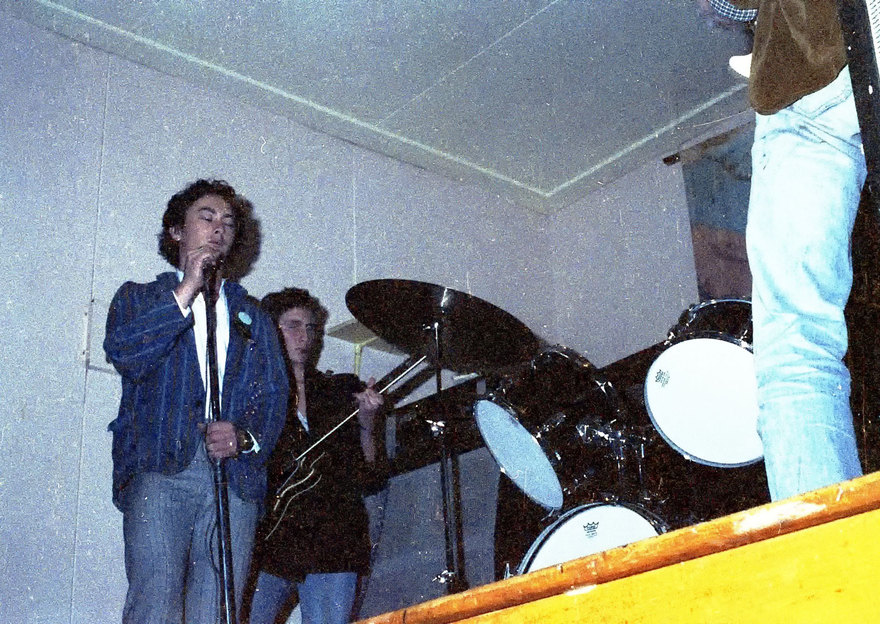
The Clean, 1978. Doug Hood on vocals - Photo by Jeff Batts
We took the prime spot up front at a white wrought iron table with youngest brother Stu as the house and balcony slowly filled around us. I was straight. No booze. Didn’t then. Lit up by the excitement because despite the new name this was The Clean – one of the great bands of the early 1980s indie boom – the line-up who had written the masterwork ‘Point That Thing (Somewhere Else)’.
The Kilgour brothers had been busy since the collapse of The Clean in late 1982. In mid-1983, they’d released (as The Great Unwashed) Clean Out Of Our Minds, a woodsy experimental album of naked acoustic and trippy psych. The Clean’s self-released classic offcuts and rarities tape Odditties also appeared in 1983, bringing to light a broader selection of sound and such indispensable songs as ‘Odditty’ and ‘At The Bottom’.

The Clean, Otago University, Dunedin 1981 - thanks to David Kilgour
Peter Gutteridge was the unknown factor. None of his post-Clean groups had endured and he had yet to contribute the three best tracks to The Great Unwashed recordings in Auckland the following week. Snapper wasn’t even in the air.
The Great Unwashed played three sets that night, 30 songs, including ‘Small Girl’, ‘Fish’, ‘Point That Thing’, ‘Slug Song’ and ‘Where You Should Be Now’. They were an acid instrumental outfit powered by surf and punk and Velvets drone and tempered by folk. It was the perfect sound for that blazing orange-lit gothic interior – two guitars and drums – with David Kilgour’s white Ibanez carving the air with none of the awkwardness of their lo-fi album recording. You couldn’t see the seams live. It was one long psychedelic splurge of folk rock jangle and out-there rockers.

Hamish Kilgour, David Kilgour, Robert Scott, 1981
Afterwards, we surrounded a calm, wine drinking David Kilgour with questions flying. I wrote it up for the third issue of Ha Ha Ha (renamed Nebulous Reasons) that came out in March 1984. He had some questions for us as well and soon found out we were starting a band. We could have played before them, he said, which delighted and terrified us in equal measure.
Anything could happen
Meeting the Kilgour brothers in early 1984 was a first. We had all the new indie records, but my small town friends and I had never met the post-punk musicians who made them. But The Clean were different. They were punk-political thinkers who’d made it clear they wanted to engage with their audience and open doors to participation. Their interviews fair rippled with ideas for the way forward with norms often questioned and alternatives offered.

The back of the Boodle Boodle Boodle pop-up press kit, 1981 - Murray Cammick Collection
Like hundreds of New Zealand teens and post-teens, I found The Clean through the five song Boodle Boodle Boodle EP in late 1981. My brothers and I located it in Chelsea Records in the Centreplace mall in Hamilton and split the EP’s $4.99 asking price three ways. The playful, optimistic tone and Andy Shaw-filmed video of ‘Anything Could Happen’ had instant appeal. There was a lot of promise and freedom in its ringing open chords and allusive lyric. We found the EP had contrasting moods, just like the Velvets. The head-down acid instrumental ‘Point That Thing (Somewhere Else)’ brought the night. ‘Anything Could Happen’ brought the day. A distinctive Chris Knox pencilled sleeve with gold and black inner label and a band-generated comic booklet capped it off.
Recorded on Knox’s TEAC 4-track with Doug Hood in Auckland in September 1981, and released in November, Boodle Boodle Boodle stayed in the NZ Singles Chart for a full half a year, from November 1981 to May 1982. For the first 10 weeks it was in the Top 20. Despite its success, NZ commercial radio refused to play it. TV chart show Ready To Roll followed step, claiming they couldn’t play the video because radio wouldn’t play the song.
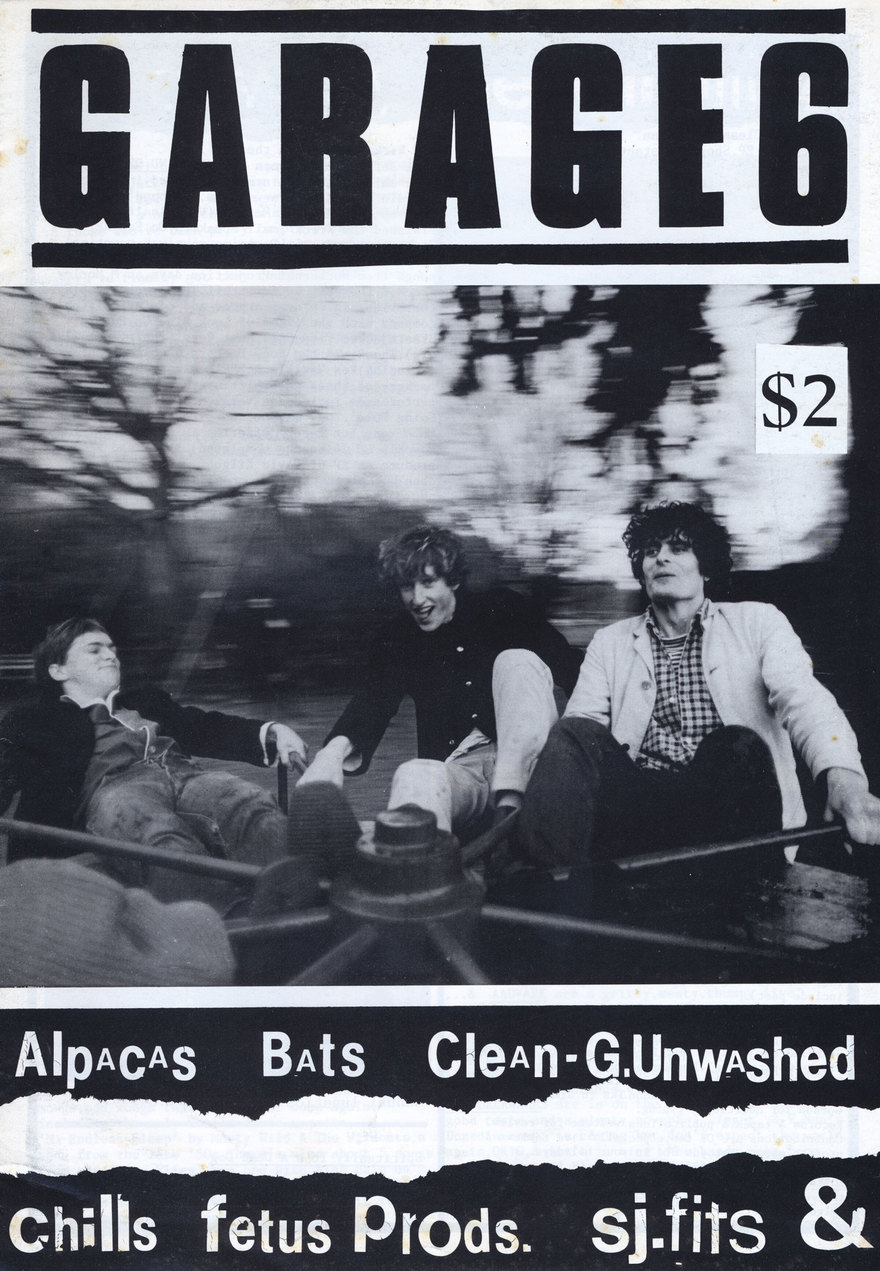
The Clean on the cover of Richard Langston's Garage 6
And as to the melange of sound and influence contained within? Hamish Kilgour told Garage fanzine in the mid-1980s “The Velvets were an influence, but that has been overstated. There was tons of stuff – west coast psychedelia, punk, post-punk, reggae, disco, sixties stuff … melody, songs with room for improvisation.” His brother David added, “Syd Barrett, Dylan, Beatles, Stones, Sex Pistols, Buzzcocks, Love, early Jefferson Airplane, New York Dolls, Stooges, Television, Gram Parsons, Jimi Hendrix, Byrds … ” All of which their new fans duly noted for future investigation.
Looking back at ‘Anything Could Happen’ in early 2012, Hamish remembered they were going for a “Highway 61/Rolling Stones country feel” born from a great affection for “20th Century folk, blues and country.”
Tally ho!
We’d been tracking The Clean through RipItUp’s Dunedin rumours column as we did all the rising bands. It was a steady and reliable source of information extracted from local fans and writers that piqued interest and added much needed detail. In September 1981, The Clean’s first full RipItUp feature appeared, titled Tally Ho!, and written by far south scene commentator Roy Colbert.

The Clean, Dunedin 1981 - Robert Scott, Hamish Kilgour and David Kilgour - Photo by Carol Tippett
“The Clean have truly done their growing up in public since first emerging under The Enemy’s wing in June 1978,” Colbert began, noting early days of “false starts, forgotten words, unintentional key changes, ignored cues, the lot,” linked by “David Kilgour’s white noise guitar and brother Hamish’s magnetism to the snare drum.”
“(David) Kilgour’s starting point appears to be an appetising ménage a trois of Byrds, early PiL and (Toy Love’s Alec) Bathgate himself,” he added, noting that The Clean had learned to fill halls with layers of sound and made real progress in their songwriting after they bought a Revox B77 2-track recorder in mid-November 1980.
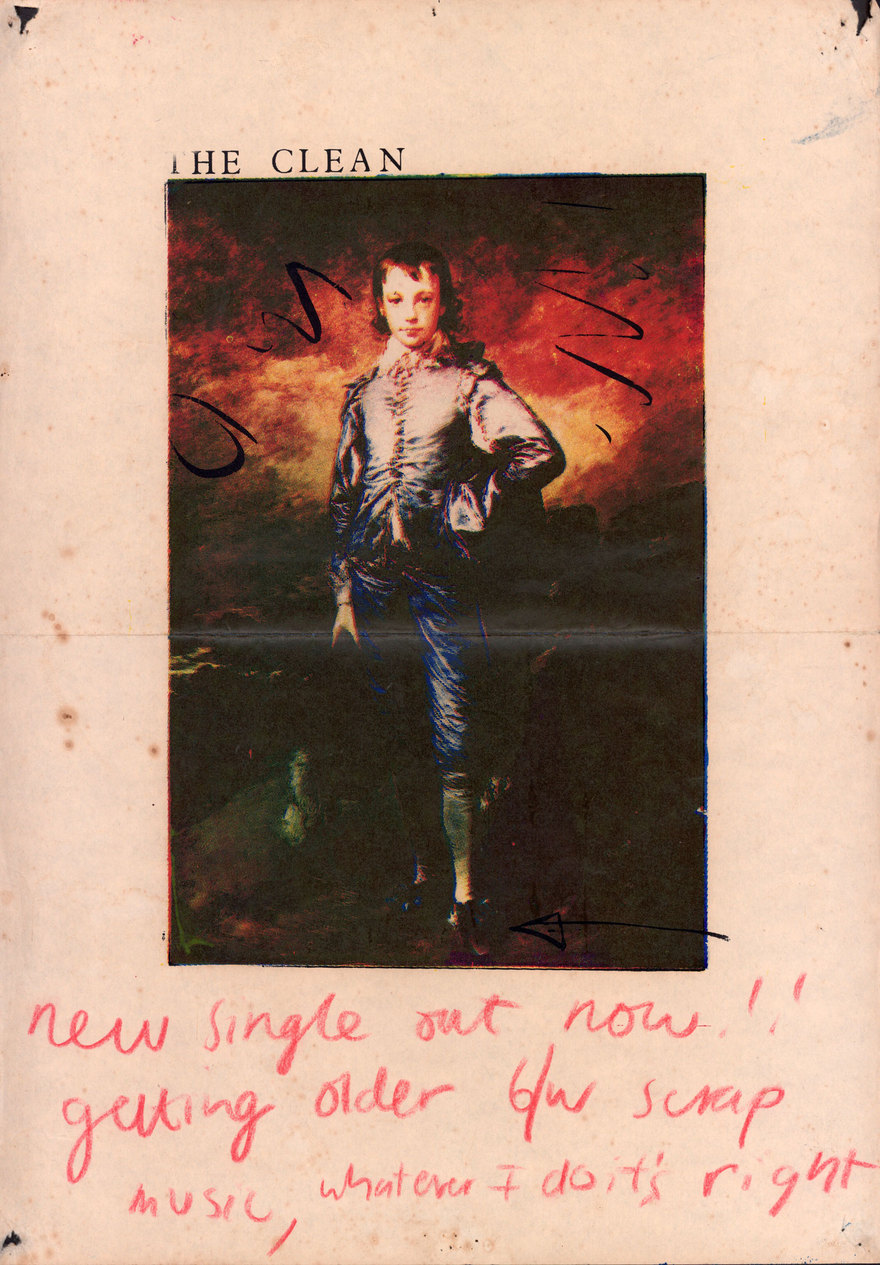
'Getting Older' poster, hand-written by Roger Shepherd - Andrew Schmidt Collection
The cultural politics came mainly from Hamish: “I think one of the most important things is getting our own musical identity – getting rid of our colonial mentality. Other New Zealand art forms like our films have been accepted overseas. There’s no reason why our records shouldn’t.”
If you needed a mission statement for the provincial indie scene of the 1980s, there it was. Clear, concise and highly relevant, these were ideas with a much discussed and mulled air about them.
The single, which the interview promoted, ‘Tally Ho!’ largely passed us by despite climbing to No.19 in the pop charts in September 1981. I can remember it peeking out from the basement wall in Tandy’s Victoria Street shop with an elaborate, silver graphic that sat strong against a pitch-black die cut sleeve. It was just one of many enduring and relevant indie records from New Zealand groups that year.
The sound was no great surprise either. The 1960s turn in NZ indie music had already happened. Toy Love and The Swingers successfully fished around in that particular pond. Auckland’s North Shore bands plus the Prime Movers and The Dabs were full of it. How Was The Air Up There? – NZ’s Nuggets – put 1960s psychedelic pop side by side with wild white R&B and weepy big ballads on release in 1979. The first two albums by The La De Da’s and Ray Columbus and The Invaders’ Anthology were in the shops again by early 1981. Christchurch groups were playing songs from Pebbles and other garage punk collections.
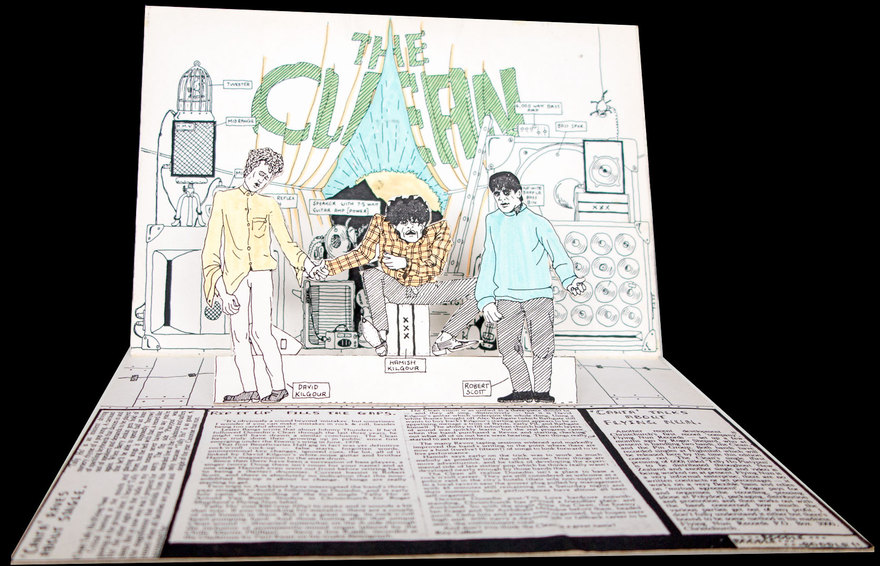
The original 1981 pop-up press release for Boodle Boodle Boodle. It was hand glued by the band.
What The Clean’s ‘Tally Ho!’ added was a very real freshness. Its chirpy, keyboard-driven hook (from The Chills’ Martin Phillipps) and happy gung-ho lyrics conveyed the sense of relief and mission that came in the weeks after the violent Springbok tour.
The Clean was already three years old in 1981. Their early years only leaked out sparingly in interviews in the decades to come. It was a surprise to find the Kilgour brothers had only recently moved to Dunedin from North Canterbury then Central Otago in the mid-1970s.
Talking to Simon Sweetman in January 2012, Hamish pointed to his early rural schooling as influential. “I had experienced radical young schoolteachers out of Christchurch in a small country high school at Cheviot in North Canterbury,” he remembered. “We had a cool art teacher, we did photography, sculptures for a small ceramic kiln and we’d be listening to radical socialist schoolteachers talking about Malthus, playing us ‘Revolution No.9’, digging Hendrix, Joe Cocker, The Who, The Stones, Led Zeppelin, The Byrds, Jim Morrison’s lyrics...”
“As a teen I devoured all of Jack Kerouac’s writing, went hitchhiking around New Zealand and hung out around the fringes and insides of Kiwi hippie, surf and glam counterculture.”
After university study in History and English at Otago University, he played briefly with The Enemy before forming The Clean with younger brother David in 1978. He was 22 and David still just 17. Early Dunedin shows with Doug Hood singing and David Kilgour’s high school friend Peter Gutteridge on bass displayed plenty of daring, but they were still finding their feet musically in Dunedin halls and at Christchurch and Invercargill shows with The Enemy in July and August 1978.
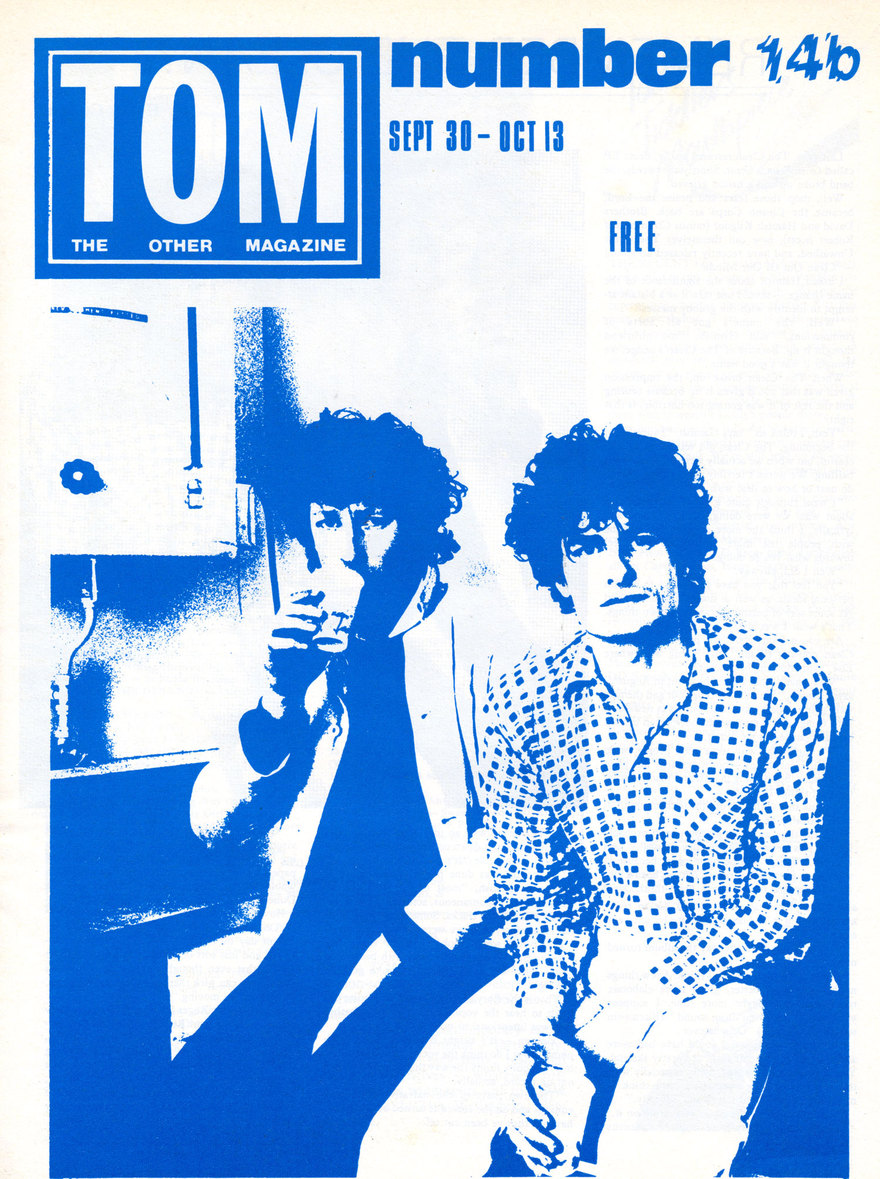
The Kilgour brothers on the cover of TOM, 1984, for The Great Unwashed
I’m in love (with these times)
The Clean hit an early peak in 1979 with the “really fast Buzzcocks/Saints guitar” of ‘Quickstep’, ‘I’m In Love (With These Times)’ and ‘Point That Thing’. That’s what Hamish told Garage’s Richard Langston in the mid-1980s. He briefly worked alongside the fanzine editor in 1978 as a Hunter S. Thompson-influenced trainee journalist at Dunedin’s Evening Star, under the guidance of Roy Colbert.
A new look Clean took those songs to Auckland in September 1979. Hamish Kilgour was up front singing, having relinquished the drum stool to Lyndsay Hooke, and Peter Gutteridge had departed to form The Cameras with Terry Moore (guitar) and Alan Haig (drums), leaving them without a bass player.
Auckland the first time proved frustrating. The Clean played just a handful of shows at Squeeze and Windsor Castle. With Hamish fronting and singing, they still lacked a regular bass player, despite trying many out, including Debbie Shadbolt and Jessica Walker (soon to form Shoes This High). An interview with Auckland Star’s Scene revealed all this and The Clean’s name’s origins in a surf movie character called Mr Clean.
David Kilgour returned to Dunedin in late 1979, where he briefly joined schoolboy punk group The Stains. Hamish stayed put in Auckland, fronting The SOBs with second-generation punks’ Michael Lawry, Pete Mesmer and Gary Hunt.
The SOBs survived into April 1980 when Hamish rejoined David and new bass player Robert Scott in a fresh-look Clean in Dunedin. The Clean’s second peak period had begun.
With Hamish drumming, The Clean linked up with teenage punks Bored Games and The Drones for a well-attended Coronation Hall show in May 1980. They were on the bill with Auckland post-punks The Features and Christchurch noiseniks The Gordons at Otago University in June for another big show, which was stopped by police for underage drinking.
Partnering up with Heavenly Bodies, Bored Games, a touring Toy Love, The Same and The Chills for live outings at Dunedin halls, concert chambers and pubs, The Clean continued to perform and improve until late April 1981 when Christchurch’s DB Gladstone beckoned.
For many fans outside Dunedin this is where The Clean story truly begins. With Robert Scott adding musical chemistry and driven, folky originals, the group packed themselves into a newly purchased van with self-customised psychedelic interior and sound system, and headed north in April 1981 for their first genuine taste of popularity.
The Clean’s relationship with Dunedin had always been an awkward one – for Hamish in particular. He saw the southern city as narrow, conservative and violent. “Dunedin had a particular strain of Presbyterian stoic Scottish repression and conformity that spun into aggression, dogmatic moralism and drinking and drug abuse as the only license to be able to let go and be a bit free,” he recalled in 2012.
Now self sufficient with their own van and PA and an ever-growing swag of original songs, The Clean set their sights on the rest of New Zealand. Christchurch warmed to them quickly. The South Island’s biggest city already had a thriving post-punk scene that was serviced by responsive venues in the DB Gladstone and Hillsborough Tavern, and a little later, the Star & Garter Tavern. It was a music scene that record shop manager Roger Shepherd, who’d travelled south for shows by The Enemy, was determined to capture and make available on record through his embryonic indie, Flying Nun Records.
After a brief trip home, Auckland beckoned the trio again in late May 1981. An extended stay in the Queen City included shows at The Rumba Bar with The Screaming Meemees and a Battle of the Bands finals performance at Mainstreet. June dates with Tall Dwarfs, The Androidss and Smelly Feet followed at The Reverb Room and Rumba Bar.
The Clean were back in Christchurch for shows in early July with The Pin Group at the Gladstone and 3ZM’s Kool Sundays at Christchurch Town Hall. They also got ‘Tally Ho!’ down in a session at Nightshift studios. Previous attempts to make vinyl had failed when their instrumental ‘At The Bottom’ arrived too late for inclusion on Propeller Records’ new band compilation, Class of ’81. They also sent songs to Auckland DJ Barry Jenkin for airplay.
‘Tally Ho!’ was no surprise hit on release in September 1981. There was already a large, demonstrated appetite for the new sounds. Post-punk scenes existed in all the major cities and NZ (and overseas) indie records peppered what was then one of the world’s most adventurous pop charts.
The impact of ‘Tally Ho!’ was most likely strongest in Dunedin where The Clean found themselves at the centre of a circle of new groups. The band’s high school performances had been already been noted by youngsters like The Verlaines’ Graeme Downes, and new venues, including the low key Pandora’s Place in South Dunedin, were appearing.
Matthew Bannister, whose Sneaky Feelings would become one of the principal new groups, recounted a Pandora’s Place show by The Clean in his memoir, Positively George Street: A personal history of Sneaky Feelings and the Dunedin Sound (1999).
“(The Clean) were at their best at a short-lived venue called Pandora’s Place near the docks in Dunedin,” Bannister wrote. “The lighting set-up was unorthodox, the room being lit normally except for the band who were in an alcove, playing in darkness. I suppose this was the ultimate statement of invisibility. The sound, however, was huge, especially when David Kilgour switched on the reverb in the Gunn amp for ‘Point That Thing’. I found it hard to believe one guy could make so much sound. It was like the room was full of flying saucers.”
A more enduring home for the extrusion of southern indie sounds wasn’t long in coming. The Empire Tavern opened in mid-August 1981 for new groups with The Clean and The Verlaines the first to grace its slender stage. The following week, The Clean returned to Christchurch. By early September, they were in Auckland before taking in Hamilton and Wellington on the trip home.
In the capital, David McLennan cornered them for an interview for the city’s free music media monthly, In Touch, which ran in the magazine’s December issue. Hamish the thinker described their music as “taking up where a lot of bands left off in 1967, 1968 with psychedelic music. That sort of crossover point between straight pop and psychedelia – an area that was never completely explored.” And their future in music? David Kilgour saw it as “a long term thing, but on a casual basis.” Another typically prescient summation from the guitarist.
In November The Clean hit the highway to promote Boodle Boodle Boodle before gathering up the rising crop of Dunedin groups – The Verlaines, The Chills, The Stones and Sneaky Feelings – for a four-date stand at the Captain Cook in mid-December.

The Verlaines and The Clean at The Gladstone, 1982 - Christchurch City Library Collection
Great sounds great…
The Clean started the New Year quietly, sparking to life in February 1982 with an After Clash Party at Christchurch nightclub PJ’s, for those who had spent money on the petition to bring The Clash south. Another round of university orientation shows in Dunedin and Christchurch followed.
With their first EP still in the Top 40, The Clean headed to Christchurch in March 1982 to capture their second 12-inch EP with chief Flying Nun enablers Chris Knox and Doug Hood. To be called Great Sounds Great, Good Sounds Good, So-so Sounds So-so, Bad Sounds Bad, Rotten Sounds Rotten, it was their best collection yet. The Clean spent the rest of their time in the garden city with orientation and pub gigs, taking time out to head over the Southern Alps to the West Coast for the Nile River Festival.
In April, The Clean appeared on the cover of RipItUp in a stark, shadowed black and white portrait. Inside, RipItUp’s Christchurch correspondent Michael Higgins quizzed them on their “shambolic majesty”. There was talk about how being away from the centre gave them freedom, self-reliance and resilience from trends, and of potential fans in Europe and parts of America.
David: “But we’d probably be regarded as passé because we’re not futuristic and image wise and it wouldn’t help because we probably look like we’re just off the farm.”
And yet, more cultural politics from Hamish, railing against big PAs, lights and how drum rostrums elevated the drummer above the audience, with David adding, “Music is trying to talk to people on a human basis. We hate the concept of pop stars.”
Hamish: “It would be good to break down the whole ritualised behaviour pattern of the audience facing bands and getting pissed. The best thing would be to move away from hotels, but that’s difficult.”
On release in May 1982, Great Sounds Great… debuted at No.4 on the pop charts. This time there was a witty, bang-on video ready to roll, set in a bohemian coffee bar. The songs also sparkled. Despite some critical reviews, the EP is in retrospect a stronger and more consistent record than Boodle. ‘Beatnik’ is a fabulous keyboard driven pop song. ‘Slug Song’ mined similar territory while ‘Fish’ was a trademark Krautrock/psych instrumental, ‘Side On’ a biting Fall-ish riffer, and ‘End Of My Dream’, a thoughtful and persistent psych-folk tune.
The Clean returned to Auckland that month, playing packed shows at The Reverb Room and The Rumba Bar, the latter of which was filmed. Two long years on from their first abortive Auckland visit, they had returned with little left to prove. That’s when it all began to unravel. By June 1982, something was amiss and The Clean were strangely quiet.
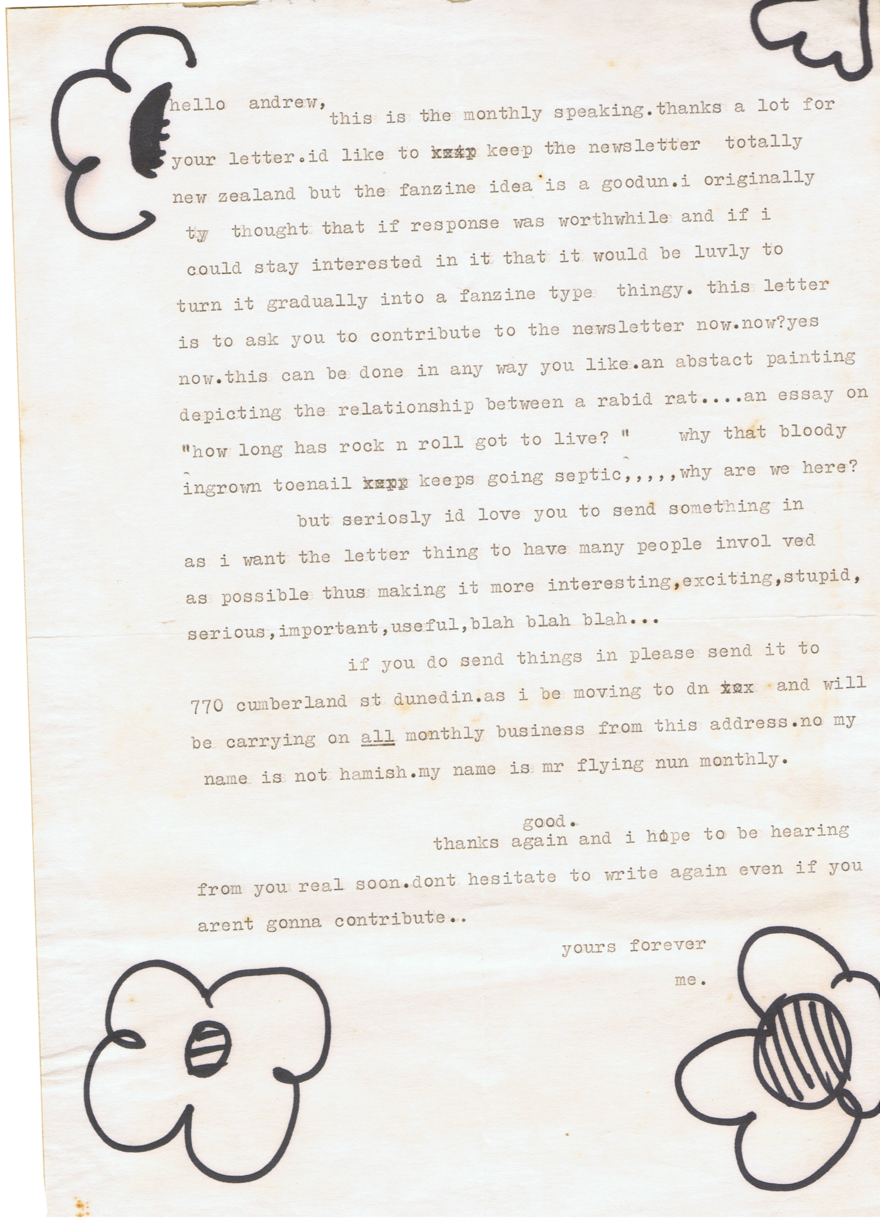
The letter from David Kilgour to Andrew Schmidt
Getting Older
In a state of semi-disbandment, The Clean rallied when offered Christchurch support slots before Mark E. Smith’s The Fall in mid-August 1982. They’d been asked to open for Teardrop Explodes in April, and turned them down, but the confrontational Fall were chart, fan and critic favourites in New Zealand, where their Northern UK provincial and indie roots struck a real chord.
Bootboy anger and ignorance marred The Clean’s set with spitting, abuse and thrown objects, forcing them and guest Martin Phillipps from the stage. Mark E. Smith, however, was impressed, giving them the thumbs up and comparing David Kilgour to Alex Chilton.
There would be one more record – the surging shambolic ‘Getting Older’, which wasn’t about the group, rather an annoying Dunedin scenester. Recorded with Knox and Hood in Auckland, the world weary/wise guitar pop gem seemed eternally on the verge of falling apart, but never quite did. It hardly dented the charts, staying barely three weeks and only making No.36 in October 1982. The Clean bowed for the second time in November 1982 with appearances at the Captain Cook Tavern in Dunedin with The Stones.
Clean out of our minds
It wasn’t unusual for groups to break up after two or three years in the early 1980s, even with substantial chart and live success. Early 1980s indie bands played more shows than later indie groups would and the charts were fickle. Even so, it felt like The Clean had short-changed us. Many young fans hadn’t had the opportunity to see them live. And what about that full songbook we’d been hearing about?
I was a regular buyer of mail order NZ indie records and tapes, dispatching letters and money with some frequency to groups and to Flying Nun Records, pestering them about future records. That’s how I first came in contact with Hamish Kilgour, who was living in Christchurch and working at Flying Nun Records. When the southern label announced a Flying Nun newsletter, I wrote to them and suggested doing a fanzine. Replies from David (the newsletter editor) in Dunedin complete with hand-drawn Warhol-ish flowers, and Hamish in Christchurch, were soon received.
When the first Ha Ha Ha appeared, Hamish’s response on Flying Nun’s letterhead was brimming with ideas and contact addresses. “Probably the first of its kind in New Zealand – it’s a real fanzine!!! Yeah!!!” he said. “Go for colour, photos etc!!!”
In July 1983, Odditties, a collection of 21 previously unreleased Clean songs, mostly recorded on the trio’s Revox B77, was made available by the group through Flying Nun. We flogged that tape to death, marvelling that The Clean’s songbook was extensive enough to relegate standout numbers such as ‘Odditty’, ‘Success Story’, ‘David Bowie’, ‘Mudchucker Blues’, ‘Hold On To The Rail’, ‘At The Bottom’, ‘In The Back’ and ‘Fats Domino’ to a retrospective tape, when they could have sat comfortably on any of the hit releases.
The Great Unwashed’s Clean Out Of Our Minds followed in September 1983. Clearly there was plenty of creative gas left in the Kilgour’s tank as songs such as ‘Small Girl’, ‘What U Should Be Now’, ‘Hold On To The Rail’, ‘Obscurity Blues’ and ‘Quickstep’ showed.
David Kilgour would remember the album as “really sloppy. It’s like its always falling apart but somehow keeps going. It was really immediate, just us waking up in the morning and recording. It’s like an extension of Odditites, the bedroom mentality.”
With Hamish living in Christchurch, RipItUp reported his younger brother was playing in The Cartilage Family (with Peter Gutteridge) and jamming with David Pine and two members of The Blue Meanies (Andrew Brough’s first group). By year’s end, The Great Unwashed were playing out with Peter Gutteridge at Dunedin’s Oriental and Empire taverns. The Clean may have left the room, but they hadn’t left the building.
I Go Wild
Meanwhile, Robert Scott, whose songs had littered The Clean’s sets, was getting on with it. His Thanks To Llamas with Toy Love’s Paul Kean (bass) and Jane Walker (drums) evolved on Walker’s departure into The Bats, with Malcolm Grant drumming and Kaye Woodward on second guitar.
Before 1983 was out, Scott’s new group would have ‘I Go Wild’, a raw primal chunk of folk rock available on the Krypton Hits tape. In October 1984, it would be the key song on The Bats’ Top 40 EP By Night. Those early Bats songs have a ramshackle joy about them that still sounds fresh today.
The urge to inform and promote was still there as well. I was sending to Dunedin for Scott’s cartoon heavy fanzine Every Secret Thing and his compilation tapes of groups from the still rising Christchurch and Dunedin indie scenes such as Songs from The Lowland (1984) and Big Southern Hits (1984).
After leaving Hamilton in January 1984, The Great Unwashed headed up state highway one to Auckland, where they performed at Limbs studio and began recording their double 7-inch package, Singles, with Terry King at Progressive. Live, The Great Unwashed were an affirmation of The Clean's best sounds – head down acid instrumentals and rich folk rock. On record, they were thinner and more frantic, and the best songs were Gutteridge’s – ‘Born In The Wrong Time’, ‘Can’t Find Water’ and ‘Boat With No Ocean’ – which swung and stung with frantic ease – although David’s ‘Neck Of The Woods’ and Hamish’s ‘Duane Eddy’ weren’t to be sniffed at.
If sniffing was your game, you always drop a nostril onto Singles’ sewn plastic sleeve, made from the backdrop for ‘Neck Of The Woods’ video with it’s Jackson Pollock-styled dripped paint surface. Singles, a minor chart hit in May 1984, was re-released as a 12-inch EP format with a different sleeve.
In August, RipItUp reported English DJ John Peel playing ‘Duane Eddy’ on his influential Radio One show, prompting Rough Trade Records in London to request 20 copies for sale. With Peter Gutteridge joining Hamish in Christchurch, The Great Unwashed expanded to a quartet with The Pin Group’s Ross Humphries, although no recordings were released with this line-up. By November 1984, David Kilgour had left the group indefinitely.
Interest in The Clean had yet to ebb away. ‘Point ‘That Thing (Somewhere Else)’ and ‘Billy Two’ from Boodle were placed on Australian compilation Beyond The Southern Cross in early 1985, and were described by NME as “excellent”.
We knew the Clean were world class, but it was always hard to judge their overseas profile. An extraordinary conversation between RipItUp’s Russell Brown and REM’s Michael Stipe published in September 1984 gave NZ fans some indication of their wider worth and place.
“I’ve only heard the Clean, and what they became, The Great Unwashed – I liked them, The Clean were a good band,” Stipe said. When asked about common influences and musical similarities, he added. “It’s something I’ve thought about myself because places as far apart as New York and Dunedin and Glasgow and Brisbane, a lot of the people we meet seem to have the same musical heritage. I don’t know if its coincidence that most of those bands happen to be really good as well. Maybe its just being away from the centre that gives you a chance to develop independent of the vagaries of fashion and gives you a chance to experiment and seek out different forms of musical expression. But I don’t really know. Most of that music’s idiosyncratic, though, which is something I value.”
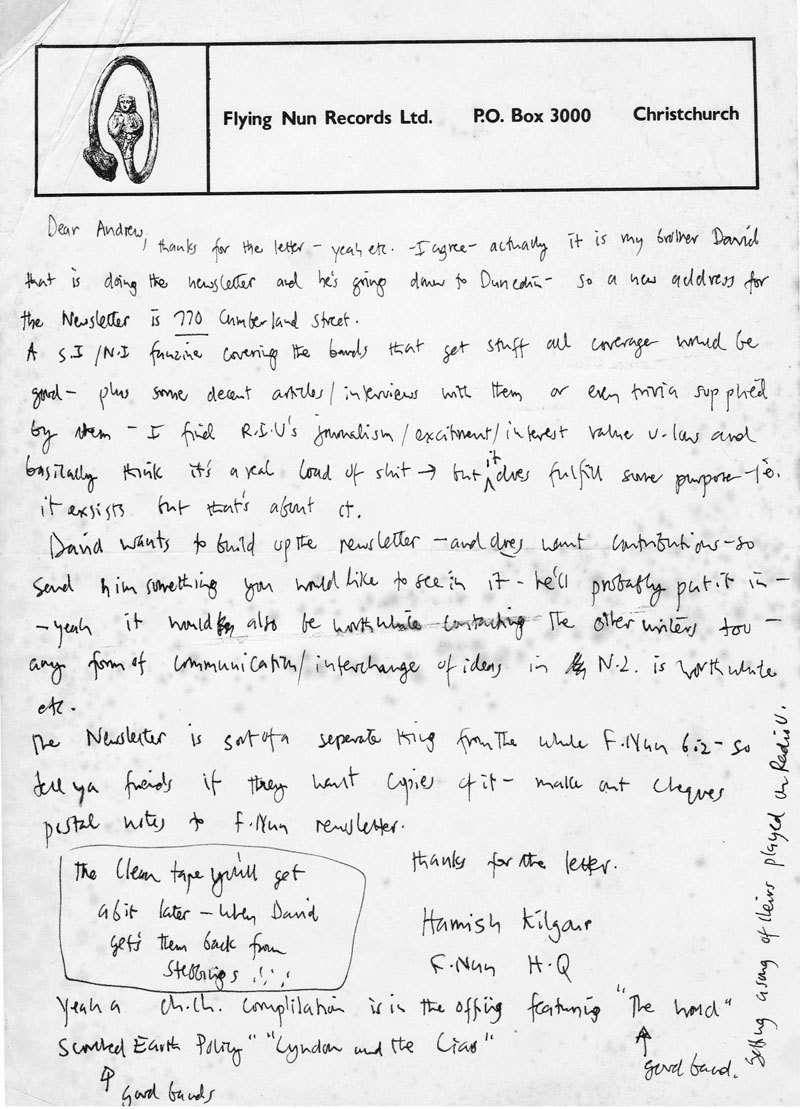
Letter from Hamish Kilgour to Andrew Schmidt
Live Dead Clean
New Zealanders maintained an appetite for the group. Live Dead Clean, an EP that collected up live recordings from shows in Auckland and Christchurch in 1981 and 1982 spent five weeks in the charts rising as high as No.23 in August 1986.
The EP title, a cheeky reference to an early Grateful Dead album, showed that The Clean’s insight and humour was still intact. Nor was their songbook depleted, as three of their final compositions’ ‘Caveman’, ‘Two Fat Sisters’ and ‘At The Bottom’ showed.
When Richard Langston’s Garage fanzine emerged from Dunedin in 1984, it was thick with unique history on the trio, particularly the last three issues, one of which had The Clean on the cover. “Safety pin folk, psychedelia, home made rock n roll,” Langston called the music, offering the opinion of “what set them apart was this weird strain of folk. Perhaps the country’s most indigenous pop ever.”
My brother Stu and I were living in Dunedin by then, drawn south by the Celtic city’s musical allure, a good part of which The Clean provided. We caught David Kilgour at arts venue Chippendale House in Stafford Street with a pick up band, including Michael Morley (The Dead C) on keyboards. After a hesitant start with The Clean’s ‘Filling A Hole’, Kilgour left the stage and didn’t return. The following year, he’d have new trio Stephen up and functioning.
Back in Christchurch, Hamish and Ross Humphries had Blue Dolphins (Twin Guitar Orchestra) with drums, cello and flute. He’d soon be drumming with Nelsh Bailter Space on their brilliant debut EP and album. Peter Gutteridge also found firm ground with Snapper while Robert Scott’s The Bats were already well established.
In 1986, Flying Nun Records collected up The Clean’s early records on Compilation, which was released in NZ, Australia, Europe and the UK, where it sold in excess of 7,000 copies. Compilation was released in the USA in 1988 on Homestead Records with six extra live tracks. A second Odditties tape in 1988 gathered up the remaining odds and sods from The Clean and The Great Unwashed.
Which would have been a good place to end it, but The Clean were about to find one hell of a second wind.
The Clean Part Two 1988 - 2014
It’s July 1988 and The Clean have arrived in London for their first overseas shows. The component parts of the New Zealand trio have come together from two hemispheres. Drummer Hamish Kilgour from New York City and Bailter Space, with whom he’s recorded a diverse and challenging EP (Nelsh Bailter Space) and album (Tanker), which are among his best work. Bass player Robert Scott is at the end of a second USA tour with The Bats, an indie pop group driven by his songs. Scott and Hamish Kilgour’s bands have just finished performing at New York’s New Music Seminar, an important indie music showcase. Guitarist David Kilgour is in Europe with his girlfriend on a long overdue overseas trip.
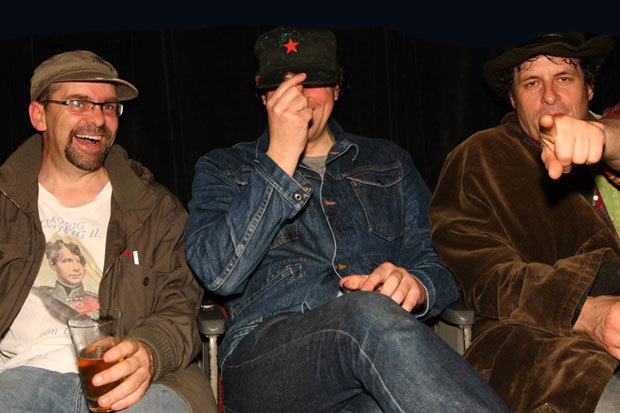
The Clean 2013, Robert Scott, David Kilgour, Hamish Kilgour - Photo by Tim Soter
The Clean played two shows in London with The Bats. The first was at Portlands on July 12 with The Dentists in support. A second performance followed on Wednesday July 13 at Fulham Greyhound with Jed Town of Fetus Productions’ ICU third on the bill.
We know this because the New Zealand Herald commissioned a story on the event, which ran in the conservative Auckland daily under the headline “Clean Up In London”. It was illustrated with a Chris Knox cartoon depiction of The Clean with no instruments, which first appeared in a promo package for their 1981 Boodle Boodle Boodle EP.
All of which left the group’s New Zealand based fans, past and present, a little put out. The situation was soon remedied by a national main centres NZ tour in May 1989, on which The Clean drew 1100 fans in Dunedin and 500 in Christchurch. The Auckland show at The Powerstation was sold out, with fans snaking out and down the footpath outside. I only just made it in the door by cutting the line, something I hadn’t done before and haven’t done since.
Writing the concert up for Waikato University student newspaper Nexus, I noted, “From the opening ‘Dadadada … daddada … da’ of ‘Fish’ with its shards of reverbed picking and white noise strum, The Clean took the capacity crowd down a rollercoaster of extreme treble nostalgia. The guy standing next to me collapsed three songs into the fray … yep, it was that good.” The set also featured some of the 15 new songs that The Clean had written.
Vehicle
Then it was on to Australia, America, Europe and Great Britain, a full-blown international tour with Chris Knox along to help. Returning to the London Fulham Greyhound, The Clean drew a 600-strong audience of New Zealanders and hip Londoners, including Geoff Travis, head of Rough Trade Records. His indie label was already well respected in New Zealand, where many of its releases were available.
Travis hadn’t heard of The Clean before the show, although some of his staff had. What he heard that night moved him to finance a new album, Vehicle, featuring 13 of those 15 new songs, which relaunched the trio in Great Britain, Australia, Europe and the United States. As the British journalist penning the NZ Herald article noted, it was all a little strange given the group were playing a form of acid pop and rock at the height of Acid House.
In June 1989, a five song live EP called In-A-Live, taped at the first Fulham Greyhound show by Jed Town, was released on the Flying Nun Europe label and in the United States, but not in New Zealand. On it, Clean perennials ‘Point That Thing Somewhere Else’, ‘Fish’, ‘Flowers’, ‘Anything Could Happen’ and ‘Whatever I Do Is Right’ burn brightly as “David Kilgour twangs away like Tom Verlaine playing at Duane Eddy.” Future praise in Melody Maker pegged the live EP as “a thing of unprecedented fire.”
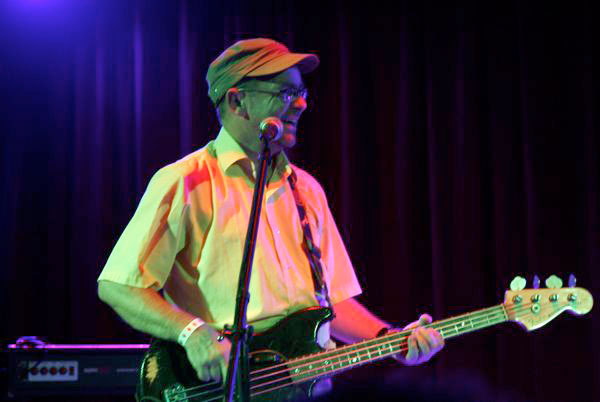
Robert Scott, The Bell House, Brooklyn, New York, May 2010 - Photo by Liz Clayton
When the tour ended, The Clean entered Blackwing studio in South London, where the Jesus and Mary Chain had just finished a record. Over four days from July 18 to 21, they recorded Vehicle with Ken Kennedy and Alan Moulder.
“It was all recorded live, the way we’d done all the records. We set up, blasted through the songs, did a day’s worth of guitar and keyboard overdubs then a day of vocals, a day of mixing and it was all done,” Robert Scott told Ian Henderson of Dunedin fanzine Alley Oop in spring 1989.
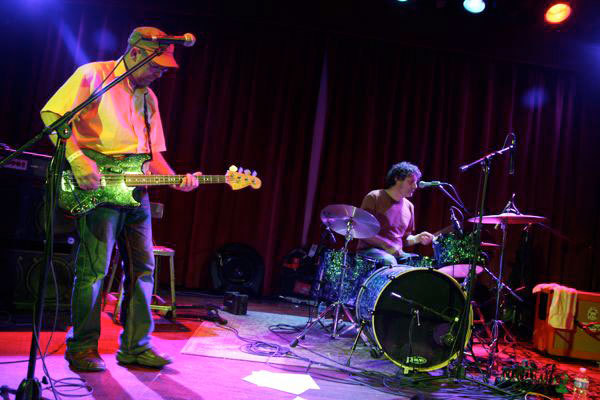
Robert Scott and Hamish Kilgour, The Bell House, Brooklyn, New York, May 2010 - Photo by Liz Clayton
Asked about The Clean’s future plans, Scott ventured: “We haven’t got any more plans to do Clean stuff unless Rough Trade want us to come back and promote the record in England. I don’t think we’ll play NZ again.” Which said more about The Clean’s relaxed approach than actual events to come. Rough Trade Records found the money for a tour, following Vehicle’s British, American and Japanese release in March 1990.
But first there was a run through New Zealand’s universities with Straitjacket Fits in February and early March 1990, where student radio and a new generation of indie fans swelled audiences. University weekly student newspapers were full of interviews with the group, mostly evangelical rants with the occasional piece of insight.
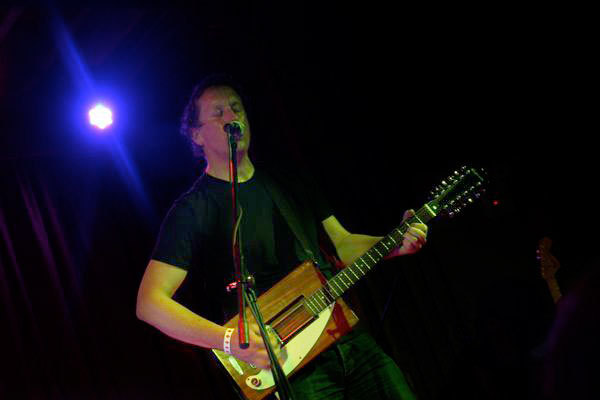
David Kilgour, The Bell House, Brooklyn, New York, May 2010 - Photo by Liz Clayton
Vehicle’s reception on release was extensive and positive. The British music press not only reviewed the record and The Clean’s supporting live performances, they made space for long interviews with the Kilgours and Scott.
Melody Maker praised the “pop oddmanship so brilliantly tilled out for the public by those artfully sussed folk at Flying Nun, down New Zealand way.” In a full interview in the same music newspaper, Paul Lester cut to the core of the album’s appeal. “The songs on Vehicle sound at once celebratory and melancholy, both happy and sad. Short, sharp, bittersweet bursts of noise and words.”
One reviewer heard “one finger solos which sometimes verge on a highland fling” and found in ‘The Blue’, the influence of Wire and The Go Betweens. It’s a revealing comment as Robert Scott and the Kilgour brothers all have immediate Celtic ancestry.
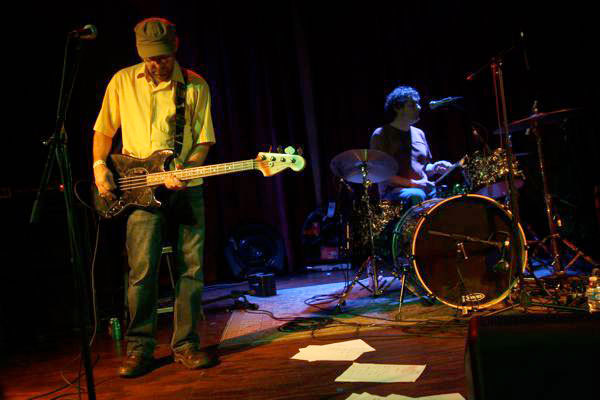
Robert Scott and Hamish Kilgour, The Bell House, Brooklyn, New York, May 2010 - Photo by Liz Clayton
In NME New Zealander David Swift was effusive, as was the New Zealand Herald. With memorable and enduring songs in Robert Scott’s ‘Dunes’ and ‘I Wait Around’ and David Kilgour’s ‘Drawing To a Whole’ and ‘Diamond Shine,’ they were right to be.
The interviews are even more revealing. In an extensive and positive full-page interview in Melody Maker, The Clean claimed to have reformed to “destroy the myth of The Clean”. They preferred to engage directly with their fans.
Hamish (33): “Our importance, if you want to call it that, is more down to the attitude we instilled in people, rather than sales or style or anything else.”
David (28): “Yeah, probably more than any other group (in NZ), we motivated a lot of people to pick up instruments and form bands.”
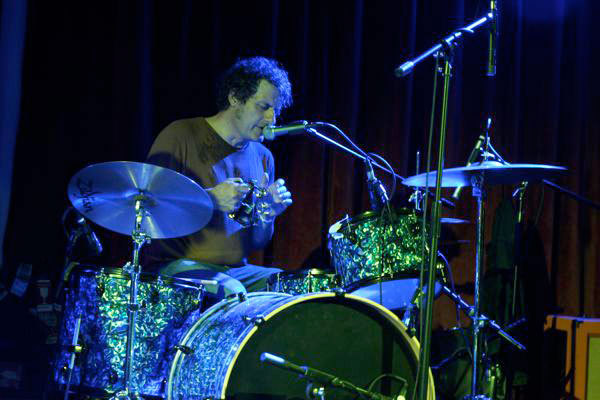
Hamish Kilgour, The Bell House, Brooklyn, New York, May 2010 - Photo by Liz Clayton
Melody Maker noted the breadth of the trio’s perceived influences. “The Clean’s interviews and articles are liberally sprinkled with the names of everyone from The Go Betweens, Television, Velvets, to German outfits like Can and Neu, to melodic sixties innovators like The Kinks, The Beatles and The Stones, through to present day noise-nihilists, Sonic Youth and Meat Puppets. The haunting acoustic pieces on Vehicle remind me of Love and Spirit at their peak while the exhilarating up-beat tracks strongly recall, of all people, Altered Images circa Pinky Blue.”
The tour that followed began in London on March 27, 1990 at Islington Powerhaus, before moving on to the Oxford Jericho Tavern in early April. Then it was on to Bedford Winkies, Brighton Richmond, Leeds Duchess of York, Hull’s Adelphi and back to London for a concert at the Subterranea. NME’s Andy Fyfe caught The Clean’s concluding London show. He described them as “the most consistently thrilling of any New Zealand act” while noting they were playing Vehicle alongside Clean classics ‘Caveman’ and ‘Point That Thing’. It was Europe next for a six-week long tour.
Back in New Zealand, fans waited months for the new album to appear on Flying Nun Records, who entered a deal with Australia’s Mushroom Records, making Vehicle available in that country as well. I couldn’t wait and picked up the Rough Trade release at Sounds Unlimited in Newmarket, Auckland. Buying an imported record by a contemporary NZ act was a new experience, but it was the only way you could get records like Vehicle promptly. Many of NZ’s best indie records came via that route and were released only on overseas indie labels in the USA, Great Britain and Europe.
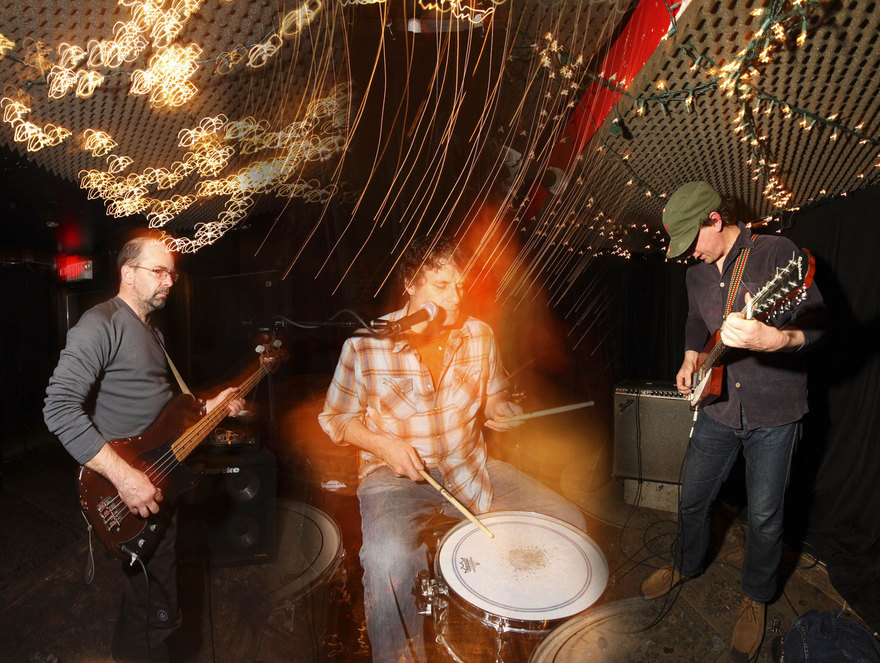
Photo by Tim Soter
When I took the album into Waikato University’s Contact FM, they carted (taped for airplay) the first two songs on side one without listening to the whole record. Typical.
In time, Vehicle was cited as a major influence by some American indie bands. It’s an intriguing idea although it’s hard to quantify influence and its impact on the resulting output. The Clean have certainly been mentioned by many groups over the years, including Pavement and Yo La Tengo, but that’s usually in a list of other perceived influences. USA College radio airplay would be a good indicator of the music’s reach, but access to playlists of the time is difficult if they have been kept at all. Strong and consistent coverage in the emerging indie publications provided the most tangible reflection of The Clean’s place in the new space that indie music opened up.
There was one immediate response in the early 1990s – The Cleaned Out 7-inch EP and flexi single on New York’s Dark Beloved Cloud label was made available in 1992. Featuring a Hamish Kilgour-drawn picture sleeve, the compilation EP presents five New York groups covering early Clean perennials, including ‘Hold On To The Rail’ and ‘Tally Ho!’.
When Vehicle was finally released in New Zealand in August 1990, it slipped into the lower reaches of the album chart for two weeks. Fans finally got a chance to celebrate The Clean’s triumphant return in October 1990 on a nationwide tour. The excursion started at Sammy’s in Dunedin on October 4 and took in all the main centres plus Palmerston North and Hamilton, before concluding with two nights at The Gluepot in Auckland.
Modern Rock
For the next four years, The Clean concentrated on personal projects. Robert Scott with The Bats along with solo and band side-projects. After dissolving his band Stephen in mid-1990, David Kilgour began his fruitful solo years. Hamish had Playground then The Mad Scene in New York. The expectation was that they’d be back when they were ready.

Modern Rock, from 1994
It was April 1994 when that happened again. The trio retreated to a community hall in Hooper’s Inlet near Dunedin and recorded Modern Rock, their second standalone album. Joining them was Alan Starrett, who played dulcimer (hammer), cello, viola, mandolin and accordion on the recording. It’s a low key, lo-fi affair featuring strong songs in ‘Secret Place’ and ‘Too Much Violence’. The album poked its head into the New Zealand charts in October 1994. Modern Rock was also released in the United Kingdom on Flying Nun Records who were taking a final (but unsuccessful) crack at that market, and in the USA on Summershine Records. A non-album single, recorded in Dunedin’s Fish St studios, of ‘Late, Last Night’ and ‘Psychedelic Clown’, appeared on New York’s Dark Beloved Cloud later that year.
The following year, a festival appearance at Strawberry Fields near Raglan in February saw Martin Phillipps joining The Clean onstage, as he has often done over the years. Unknown Country followed in 1996, having been recorded at Fish St studios in Dunedin in autumn 1995 with Starrett again contributing strongly, but Unknown Country is their least compelling album so far.
Sifting through The Clean’s non-compilation albums is like sifting through garage punk compilations of old. There are real gems to be found such as ‘Stars’ and ‘Jala’ on Getaway (2001) released on Matador Records in Europe and Merge Records in the USA. Recorded following Hamish Kilgour’s trip home for the Dunedin Arts Festival, it sparked The Clean’s creative fire anew. Like all The Clean’s records, Getaway started in the practice room, with recording stretching over four studios. Fans Georgia Hubley and Ira Kaplan from Yo La Tengo contributed to two songs.
An extensive American tour in support of what is The Clean’s most consistent album since Vehicle began in New York in early September 2001, a month forever linked with terrorist attacks on New York’s Twin Towers and on The Pentagon, which caused great loss of innocent life.
Point That Thing Somewhere Else (a slight return)
The Clean entered the new millennium on the front foot. They had an ambitious and stable record company in Merge Records and a formidable live show capable of thrilling fans old and new. A NZ national tour in late 2000 nailed this home and was captured as Syd’s Pink Wiring System, a self-released live album that was issued to coincide with their 2003 USA tour. With yet more help from Martin Phillipps, it presents a selection of the best of the group’s songs in all their live glory from October and November dates at Dunedin’s Sammy’s and Arc Cafe. Particularly strong were the group’s acid instrumentals such as the new ‘Stars’, ‘Fish’ and old faithful, ‘Point That Thing’.
In 2001, ‘Fish’ and ‘Quickstep’ bookended one of the rarest releases from the trio, Slush Fund (Arclife CD). The EP also features classic Clean songs 'Filling A Hole' and 'Caveman' alongside a startling piano-led take on ‘Point That Thing’ recorded live in Wellington’s Marmalade studios on February 28, 1999. With David Kilgour on piano and Robert Scott and Hamish toned down, it is a remarkable and dynamic revisiting which lacks none of the original’s ebb and flow power.

2011 Australian tour poster
‘Point That Thing’ is a song that is often singled out for praise in reviews and a constant presence on many of the available live recordings of The Clean. You can hear an early version on Odditties 2 (1988) called ‘Point That Thing #3’, captured at Logan Park High School in Dunedin in 1979 and featuring the Kilgour, Kilgour, Peter Gutteridge (bass) and Lindsay Hooke (drums) line-up. The song’s rhythm and gait is there already, but not the full guitar voice. Odditties 1 (1983) finds The Clean experimenting with echo, repetition and reverb on a dub version of ‘Point That Thing’ taped in Selwyn College’s billiard and practice rooms in 1980.
When Boodle Boodle Boodle appeared in 1981, there was yet another version present. Recorded on 4-track, that take has been reissued multiple times over the years. When a copy of the EP made its way to Australian music magazine RAM in 1982, the reviewer astutely placed the group and the song in a wider musical lineage as “superb promoters of a uniquely Kiwi acid consciousness.”
“The Clean are a three-piece Kiwi outfit who play a hybrid Byrds meets Lou Reed style moaning rock in the best put me down on a four track and see what it sounds like amateur tradition. This mini album was recorded late last year, but for all intents and purposes could have been made in 1968 San Francisco, especially the acid-inspiring ‘Point That Thing Somewhere Else’. If the entire album had the fluid drive and intensity transcendent of this track The Clean could mean something …”
In Wellington’s In Touch (1981), David McLennan pegs “The closing out number, ‘Point That Thing Somewhere Else’" as the pièce de résistance. "Five and a half minutes of relentless driving psychedelia, it takes the Velvets on at their own game and wins hands down. It’s probably the best thing ever recorded by a local band.”
David Kilgour told McLennan the secret of the sound: “Just full treble. I don’t have any bass on it at all, and just reverb, that’s all it is. I’m trying to get away from using the reverb too much. The amp’s got JBL speakers and they’re really trebly which helps.”
‘Point That Thing’ also sizzles synapses live. The July 1988 London shows prompt David Swift in NME to proclaim, “Their freeway flyer, ‘Point That Thing Somewhere Else’ has became an anthem in the same way as ‘I’m Stranded’ or ‘Television Addict’.”
Reviewing the same show in New Zealand Herald, Martin Aston concurred. “It is The Clean’s acknowledged opus. David Kilgour’s incendiary guitar established a strobe-like pattern before smothering the rhythm with clusters of notes.”
You can hear ‘Point That Thing’s’ influence in other NZ indie groups of the 1980s as well and more recently in Ghost Wave and Surf Friends. In much the same way as the ringing open chords of ‘Anything Could Happen’ enabled dozens of simple but catchy folk pop songs, the linear, ascending and descending single string notes, complemented by an open droning string sound above, inhabits many driving transcendent numbers.
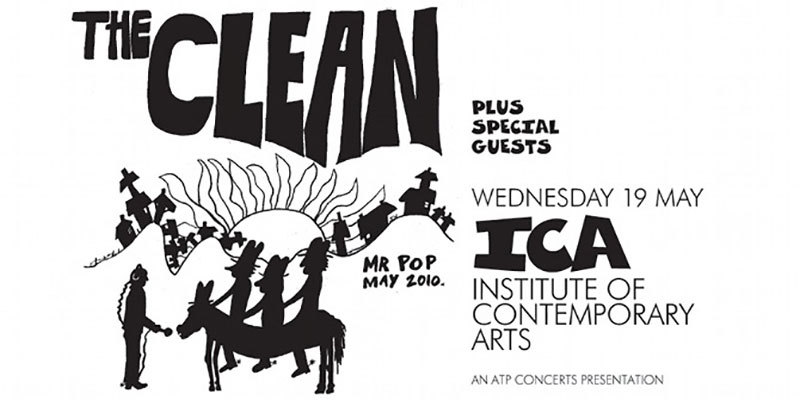
The Clean at The ICA, London, May 2010
Direct covers of ‘Point That Thing’ also exist. HDU and Peter Gutteridge (in case you’ve forgotten one of the song’s composers) chipped in a take for the God Save The Clean (1998) compilation and US group Kinski altered very little for their Semaphore Sub Pop Records CD maxi-single take in 2002.
An intriguing sampling of ‘Point That Thing’ by SJD for his Southern Light Pic n Mix version of ‘From A To B’ was remixed in 2005 by Greg Churchill, who clearly hears and utilises the danceable krautrock rhythm of the original. The remix appears on Churchill’s UK release It’s Only A Mixtape: Volume 1 (Ministry of Sound) in 2006.
Anthology
In compiling the best of The Clean’s early years on one CD and their later years on another for the popular Anthology (2003), Merge Records struck a rich vein of interest for The Clean in the United States. Their resurgence made them an enduring, financially viable touring act for the first time and set up the next phase of the trio’s long career.
Talking with Grant Smithies for his book Soundtrack: 118 Great New Zealand Albums (2007), David Kilgour reflected on the compilation’s importance. “Well, it’s always great when other people like your songs, whoever they are. The main thing this anthology shows is that we made some very accessible and melodic pop songs over the years. People have called us a psychedelic punk group and I’m happy with that. Not hug-the-trees, drop-some-acid hippie psychedelia, but we’re part of that long line of psychedelic garage bands made up of young white people going nuts with electric instruments. Someone once described this kind of music as the sound of Western civilisation collapsing, and I can’t think of any way I’d rather sound.”

The Clean, The ICA London, 19 May 2010 - Photo by Ewan Munro
The Clean hit the highway in June 2003 for an extensive tour in support of Anthology, starting in New York at the famous avant-garde Knitting Factory venue. The tour took in Detroit, Chicago, Minneapolis, Denver, Seattle, Portand, Vancouver and the Fillmore in San Francisco, all cities with names that resonate in counter-culture and post-punk history.
Drawing To A Whole
Hard on the heels of a David Kilgour solo tour in November 2007, The Clean returned to America for dates at New York’s Cakeshop and Other Music. They headed down to Johnny Brenda’s in Philadelphia in December, before joining their friends Yo La Tengo at Maxwell’s in Hoboken.
It was a comfortable routine by now, as David Kilgour told Gavin Bertram in NZ Musician in August 2009. “It’s like getting back with your brothers and jumping on the same old bikes and riding through the same old playground,” he explained. “Except that we’re middle-aged men now. But the playing together seems very natural.”
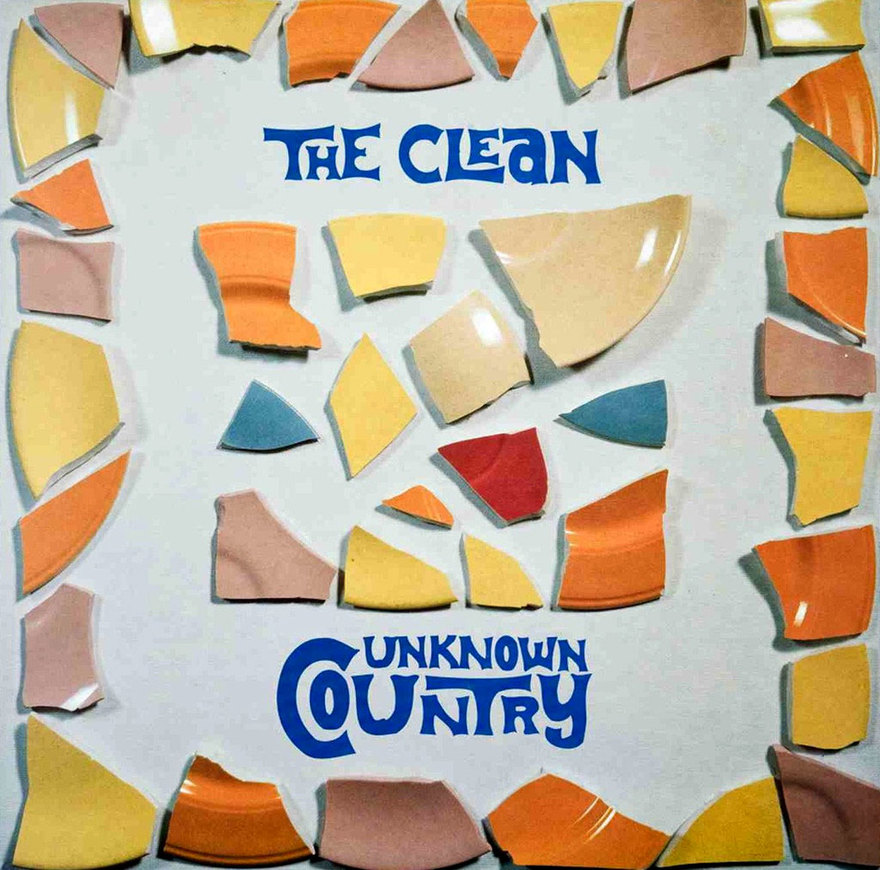
Unknown Country, 1996
Being a part time proposition meant not really knowing who their audience was anymore, Kilgour added. “When we did those shows in New York they were half young kids and half everything else. It was like, ‘Shit, where the hell did they come from?’ Maybe The Clean’s Anthology album (2003) has really spread over the time. Maybe they’re the kids of the old indie rockers or it’s college radio.”
New Zealand had already seen The Clean in March 2007. After a tour opener in Wellington and a charity show in Auckland in support of an old fan’s son’s education, The Clean headed north to the idyllic Leigh Sawmill Cafe on March 18. Hamish Kilgour, their pounding, motorik drummer, turned 50 a few days before, and that evening the crowd sung him a hearty ‘Happy Birthday’. Imagine that – half a century – 30 years since punk turned his head and he formed a ramshackle trio to play his and his brother David’s songs and sounds, a body of work that became one of New Zealand’s most loved.
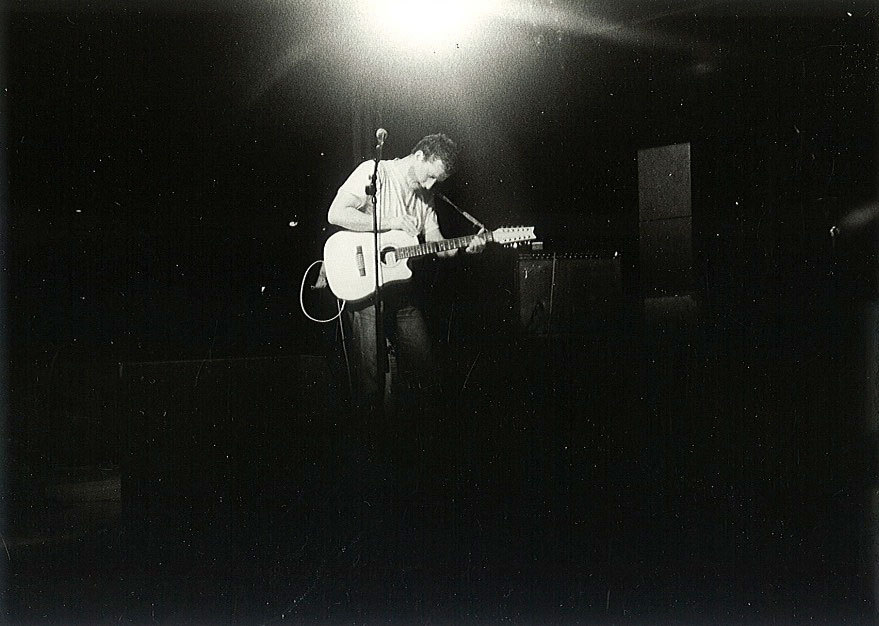
David Kilgour in the early 1990s - Photo by Chris Knox
There’d be incendiary moments and unexpected high points in the night’s three-hour set, including bass player Robert Scott's ‘Dunes’ from Vehicle and a rave up Kilgour moment in ‘Billy Two’. Their two best albums – 2000’s Getaway and 1990’s Vehicle – got a good airing and the early Clean classics were all present. The opener, ‘Fish’ sparkled, then it was straight into ‘Drawing To A Whole’, their pop-folk side, launching a long set that trawled through one of the great New Zealand songbooks.
There was a raw version of ‘I’m In Love With These Times’ (first recorded by Nelsh Bailter Space) that showed what the early punk Clean must have sounded like. Their first encore was The Velvet Underground’s VU nugget ‘I Can’t Stand It’ and The Rolling Stones’ ‘I'm Free’, both brilliant interpretations. David’s guitar playing on ‘I Can’t Stand It’ would have done Sterling Morrison and John Cale proud.
More encores followed, ‘Beatnik’ included. The group were buoyant throughout, joking with the crowd and among themselves, as comfortable now being a great NZ rock group as their fans are having them as one.
The Bangers and Mash tour concluded in late March with South Island shows in Oamaru, Dunedin, Christchurch and Lyttelton.
Mister Pop
The Clean head out to the world with some regularity now, having found an ongoing audience there, as David Kilgour predicted all those years ago they would. They were back in New York in May 2010, where Hamish still lives, for the Stroke benefit for Chris Knox and stayed on for a show with Dimmer at The Bell House in Brooklyn. Then it was back to England where they joined Pavement at the Brixton Academy.
Pavement were in England as hosts of All Tomorrow’s Parties at Butlins in Minehead, where The Clean and The 3Ds were on the bill. The Spring Tour of Europe followed after a second ATP in Bristol and a night with Jowe Head at London’s Institute of Contemporary Arts. After the Paradiso in Amsterdam, Hamburg, Berlin, Leipzig, Hasselt and Paris, The Clean finished up at Primavera Sound Festival in Barcelona.
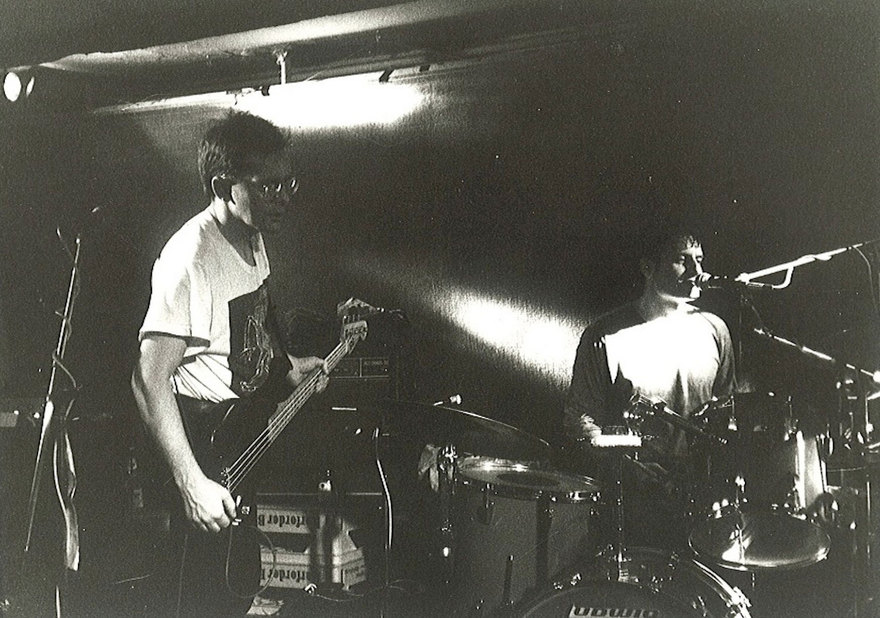
Robert Scott and Hamish Kilgour, Europe, early 1990s - Photo by Chris Knox
In September 2010, The Clean reconvened in Melbourne then jumped the Pacific to Los Angeles on a tour taking in Seattle, New York, New Jersey, Chicago, the Scion Garage Fest, San Francisco and Portland. The following year in March they were in Sydney, Fortitude Valley, Queensland and Melbourne and played a spot at the Golden Plains Festival in Victoria.
Back home in New Zealand, The Clean were onstage at The Big Day Out in Auckland in 2008. A new album, Mister Pop, released on Arch Hill, Merge and Morr Music (Europe), was recorded in Dunedin in early 2009 and issued later that year, housed in a lurid green paisley sleeve. In 2011, The Clean were part of Flying Nun Records 30th anniversary celebrations, although they wisely stuck with Arch Hill Records as their NZ label.
The Clean’s music continues to be reissued, with Odditties getting a double LP vinyl release in 2012, and the album that started the second leg of their journey, Vehicle, available again in 2013. It has a double gatefold sleeve this time around and extensive liner notes from the group, including David Kilgour’s hash-flavoured memories. All wrapped in his vivid yellow and cream cover painting of a primitive guitar that has the texture of peeling paint on a barn wall.
And so it goes. What are the chances they’ll take some time to record again? Good, I think.
“We resented the one way culture traffic into New Zealand…” - The Clean
We were living in the bottom flat of a two-storey concrete block on the east side of the Waikato River in the upper North Island city of Hamilton, my brother Gonzo, the Christian and I. Working and studying and obsessing about our favourite indie bands in a small inky, stencil-cut fanzine called Ha Ha Ha, which we’d drop in record shops in town and send to Ima Hitt in New Plymouth and Flying Nun Records to distribute.

The Clean, 1978, at Beneficiaries Hall, Dunedin. Doug Hood (vocals), David Kilgour (guitar), Peter Gutteridge (bass), Hamish Kilgour (drums) - Photo by Jeff Batts
I’d been corresponding with The Clean’s drummer Hamish Kilgour at Flying Nun HQ in Christchurch and he posted me a brightly screened poster announcing his new group, The Great Unwashed’s January 1984 Great Outdoors Tour. At the bottom, someone had written, “get to this gig guys and gals and we will have ourselves a hoedown.” Hamish, we supposed.
A grass roots tour of New Zealand? It was one of those overtly punk-political things the Kilgour brothers Hamish and David did. Punk had taken music back to the kids and the fans. They’d take it to the provincial cities and coastal towns. They were down to play Waihi Beach, Whangamata and Hamilton – all within easy reach.
It was at The Left Bank Theatre, an old black painted velvet carpeted theatre with balcony and chandelier on the Waikato River’s left bank, that we cornered them finally. The Great Unwashed had a minimal stage set-up which included the long open tube lamp later used as the cover photo on The Clean’s 1982 Great Sounds Great EP, which cast a bright hot orange-gold light over everything between it and the black walls and ceiling. Behind that, they propped three long rough wooden stakes in a skeleton teepee.

The Clean, 1978. Doug Hood on vocals - Photo by Jeff Batts
We took the prime spot up front at a white wrought iron table with youngest brother Stu as the house and balcony slowly filled around us. I was straight. No booze. Didn’t then. Lit up by the excitement because despite the new name this was The Clean – one of the great bands of the early 1980s indie boom – the line-up who had written the masterwork ‘Point That Thing (Somewhere Else)’.
The Kilgour brothers had been busy since the collapse of The Clean in late 1982. In mid-1983, they’d released (as The Great Unwashed) Clean Out Of Our Minds, a woodsy experimental album of naked acoustic and trippy psych. The Clean’s self-released classic offcuts and rarities tape Odditties also appeared in 1983, bringing to light a broader selection of sound and such indispensable songs as ‘Odditty’ and ‘At The Bottom’.

The Clean, Otago University, Dunedin 1981 - thanks to David Kilgour
Peter Gutteridge was the unknown factor. None of his post-Clean groups had endured and he had yet to contribute the three best tracks to The Great Unwashed recordings in Auckland the following week. Snapper wasn’t even in the air.
The Great Unwashed played three sets that night, 30 songs, including ‘Small Girl’, ‘Fish’, ‘Point That Thing’, ‘Slug Song’ and ‘Where You Should Be Now’. They were an acid instrumental outfit powered by surf and punk and Velvets drone and tempered by folk. It was the perfect sound for that blazing orange-lit gothic interior – two guitars and drums – with David Kilgour’s white Ibanez carving the air with none of the awkwardness of their lo-fi album recording. You couldn’t see the seams live. It was one long psychedelic splurge of folk rock jangle and out-there rockers.

Hamish Kilgour, David Kilgour, Robert Scott, 1981
Afterwards, we surrounded a calm, wine drinking David Kilgour with questions flying. I wrote it up for the third issue of Ha Ha Ha (renamed Nebulous Reasons) that came out in March 1984. He had some questions for us as well and soon found out we were starting a band. We could have played before them, he said, which delighted and terrified us in equal measure.
Anything could happen
Meeting the Kilgour brothers in early 1984 was a first. We had all the new indie records, but my small town friends and I had never met the post-punk musicians who made them. But The Clean were different. They were punk-political thinkers who’d made it clear they wanted to engage with their audience and open doors to participation. Their interviews fair rippled with ideas for the way forward with norms often questioned and alternatives offered.

The back of the Boodle Boodle Boodle pop-up press kit, 1981 - Murray Cammick Collection
Like hundreds of New Zealand teens and post-teens, I found The Clean through the five song Boodle Boodle Boodle EP in late 1981. My brothers and I located it in Chelsea Records in the Centreplace mall in Hamilton and split the EP’s $4.99 asking price three ways. The playful, optimistic tone and Andy Shaw-filmed video of ‘Anything Could Happen’ had instant appeal. There was a lot of promise and freedom in its ringing open chords and allusive lyric. We found the EP had contrasting moods, just like the Velvets. The head-down acid instrumental ‘Point That Thing (Somewhere Else)’ brought the night. ‘Anything Could Happen’ brought the day. A distinctive Chris Knox pencilled sleeve with gold and black inner label and a band-generated comic booklet capped it off.
Recorded on Knox’s TEAC 4-track with Doug Hood in Auckland in September 1981, and released in November, Boodle Boodle Boodle stayed in the NZ Singles Chart for a full half a year, from November 1981 to May 1982. For the first 10 weeks it was in the Top 20. Despite its success, NZ commercial radio refused to play it. TV chart show Ready To Roll followed step, claiming they couldn’t play the video because radio wouldn’t play the song.

The Clean on the cover of Richard Langston's Garage 6
And as to the melange of sound and influence contained within? Hamish Kilgour told Garage fanzine in the mid-1980s “The Velvets were an influence, but that has been overstated. There was tons of stuff – west coast psychedelia, punk, post-punk, reggae, disco, sixties stuff … melody, songs with room for improvisation.” His brother David added, “Syd Barrett, Dylan, Beatles, Stones, Sex Pistols, Buzzcocks, Love, early Jefferson Airplane, New York Dolls, Stooges, Television, Gram Parsons, Jimi Hendrix, Byrds … ” All of which their new fans duly noted for future investigation.
Looking back at ‘Anything Could Happen’ in early 2012, Hamish remembered they were going for a “Highway 61/Rolling Stones country feel” born from a great affection for “20th Century folk, blues and country.”
Tally ho!
We’d been tracking The Clean through RipItUp’s Dunedin rumours column as we did all the rising bands. It was a steady and reliable source of information extracted from local fans and writers that piqued interest and added much needed detail. In September 1981, The Clean’s first full RipItUp feature appeared, titled Tally Ho!, and written by far south scene commentator Roy Colbert.

The Clean, Dunedin 1981 - Robert Scott, Hamish Kilgour and David Kilgour - Photo by Carol Tippett
“The Clean have truly done their growing up in public since first emerging under The Enemy’s wing in June 1978,” Colbert began, noting early days of “false starts, forgotten words, unintentional key changes, ignored cues, the lot,” linked by “David Kilgour’s white noise guitar and brother Hamish’s magnetism to the snare drum.”
“(David) Kilgour’s starting point appears to be an appetising ménage a trois of Byrds, early PiL and (Toy Love’s Alec) Bathgate himself,” he added, noting that The Clean had learned to fill halls with layers of sound and made real progress in their songwriting after they bought a Revox B77 2-track recorder in mid-November 1980.

'Getting Older' poster, hand-written by Roger Shepherd - Andrew Schmidt Collection
The cultural politics came mainly from Hamish: “I think one of the most important things is getting our own musical identity – getting rid of our colonial mentality. Other New Zealand art forms like our films have been accepted overseas. There’s no reason why our records shouldn’t.”
If you needed a mission statement for the provincial indie scene of the 1980s, there it was. Clear, concise and highly relevant, these were ideas with a much discussed and mulled air about them.
The single, which the interview promoted, ‘Tally Ho!’ largely passed us by despite climbing to No.19 in the pop charts in September 1981. I can remember it peeking out from the basement wall in Tandy’s Victoria Street shop with an elaborate, silver graphic that sat strong against a pitch-black die cut sleeve. It was just one of many enduring and relevant indie records from New Zealand groups that year.
The sound was no great surprise either. The 1960s turn in NZ indie music had already happened. Toy Love and The Swingers successfully fished around in that particular pond. Auckland’s North Shore bands plus the Prime Movers and The Dabs were full of it. How Was The Air Up There? – NZ’s Nuggets – put 1960s psychedelic pop side by side with wild white R&B and weepy big ballads on release in 1979. The first two albums by The La De Da’s and Ray Columbus and The Invaders’ Anthology were in the shops again by early 1981. Christchurch groups were playing songs from Pebbles and other garage punk collections.

The original 1981 pop-up press release for Boodle Boodle Boodle. It was hand glued by the band.
What The Clean’s ‘Tally Ho!’ added was a very real freshness. Its chirpy, keyboard-driven hook (from The Chills’ Martin Phillipps) and happy gung-ho lyrics conveyed the sense of relief and mission that came in the weeks after the violent Springbok tour.
The Clean was already three years old in 1981. Their early years only leaked out sparingly in interviews in the decades to come. It was a surprise to find the Kilgour brothers had only recently moved to Dunedin from North Canterbury then Central Otago in the mid-1970s.
Talking to Simon Sweetman in January 2012, Hamish pointed to his early rural schooling as influential. “I had experienced radical young schoolteachers out of Christchurch in a small country high school at Cheviot in North Canterbury,” he remembered. “We had a cool art teacher, we did photography, sculptures for a small ceramic kiln and we’d be listening to radical socialist schoolteachers talking about Malthus, playing us ‘Revolution No.9’, digging Hendrix, Joe Cocker, The Who, The Stones, Led Zeppelin, The Byrds, Jim Morrison’s lyrics...”
“As a teen I devoured all of Jack Kerouac’s writing, went hitchhiking around New Zealand and hung out around the fringes and insides of Kiwi hippie, surf and glam counterculture.”
After university study in History and English at Otago University, he played briefly with The Enemy before forming The Clean with younger brother David in 1978. He was 22 and David still just 17. Early Dunedin shows with Doug Hood singing and David Kilgour’s high school friend Peter Gutteridge on bass displayed plenty of daring, but they were still finding their feet musically in Dunedin halls and at Christchurch and Invercargill shows with The Enemy in July and August 1978.

The Kilgour brothers on the cover of TOM, 1984, for The Great Unwashed
I’m in love (with these times)
The Clean hit an early peak in 1979 with the “really fast Buzzcocks/Saints guitar” of ‘Quickstep’, ‘I’m In Love (With These Times)’ and ‘Point That Thing’. That’s what Hamish told Garage’s Richard Langston in the mid-1980s. He briefly worked alongside the fanzine editor in 1978 as a Hunter S. Thompson-influenced trainee journalist at Dunedin’s Evening Star, under the guidance of Roy Colbert.
A new look Clean took those songs to Auckland in September 1979. Hamish Kilgour was up front singing, having relinquished the drum stool to Lyndsay Hooke, and Peter Gutteridge had departed to form The Cameras with Terry Moore (guitar) and Alan Haig (drums), leaving them without a bass player.
Auckland the first time proved frustrating. The Clean played just a handful of shows at Squeeze and Windsor Castle. With Hamish fronting and singing, they still lacked a regular bass player, despite trying many out, including Debbie Shadbolt and Jessica Walker (soon to form Shoes This High). An interview with Auckland Star’s Scene revealed all this and The Clean’s name’s origins in a surf movie character called Mr Clean.
David Kilgour returned to Dunedin in late 1979, where he briefly joined schoolboy punk group The Stains. Hamish stayed put in Auckland, fronting The SOBs with second-generation punks’ Michael Lawry, Pete Mesmer and Gary Hunt.
The SOBs survived into April 1980 when Hamish rejoined David and new bass player Robert Scott in a fresh-look Clean in Dunedin. The Clean’s second peak period had begun.
With Hamish drumming, The Clean linked up with teenage punks Bored Games and The Drones for a well-attended Coronation Hall show in May 1980. They were on the bill with Auckland post-punks The Features and Christchurch noiseniks The Gordons at Otago University in June for another big show, which was stopped by police for underage drinking.
Partnering up with Heavenly Bodies, Bored Games, a touring Toy Love, The Same and The Chills for live outings at Dunedin halls, concert chambers and pubs, The Clean continued to perform and improve until late April 1981 when Christchurch’s DB Gladstone beckoned.
For many fans outside Dunedin this is where The Clean story truly begins. With Robert Scott adding musical chemistry and driven, folky originals, the group packed themselves into a newly purchased van with self-customised psychedelic interior and sound system, and headed north in April 1981 for their first genuine taste of popularity.
The Clean’s relationship with Dunedin had always been an awkward one – for Hamish in particular. He saw the southern city as narrow, conservative and violent. “Dunedin had a particular strain of Presbyterian stoic Scottish repression and conformity that spun into aggression, dogmatic moralism and drinking and drug abuse as the only license to be able to let go and be a bit free,” he recalled in 2012.
Now self sufficient with their own van and PA and an ever-growing swag of original songs, The Clean set their sights on the rest of New Zealand. Christchurch warmed to them quickly. The South Island’s biggest city already had a thriving post-punk scene that was serviced by responsive venues in the DB Gladstone and Hillsborough Tavern, and a little later, the Star & Garter Tavern. It was a music scene that record shop manager Roger Shepherd, who’d travelled south for shows by The Enemy, was determined to capture and make available on record through his embryonic indie, Flying Nun Records.
After a brief trip home, Auckland beckoned the trio again in late May 1981. An extended stay in the Queen City included shows at The Rumba Bar with The Screaming Meemees and a Battle of the Bands finals performance at Mainstreet. June dates with Tall Dwarfs, The Androidss and Smelly Feet followed at The Reverb Room and Rumba Bar.
The Clean were back in Christchurch for shows in early July with The Pin Group at the Gladstone and 3ZM’s Kool Sundays at Christchurch Town Hall. They also got ‘Tally Ho!’ down in a session at Nightshift studios. Previous attempts to make vinyl had failed when their instrumental ‘At The Bottom’ arrived too late for inclusion on Propeller Records’ new band compilation, Class of ’81. They also sent songs to Auckland DJ Barry Jenkin for airplay.
‘Tally Ho!’ was no surprise hit on release in September 1981. There was already a large, demonstrated appetite for the new sounds. Post-punk scenes existed in all the major cities and NZ (and overseas) indie records peppered what was then one of the world’s most adventurous pop charts.
The impact of ‘Tally Ho!’ was most likely strongest in Dunedin where The Clean found themselves at the centre of a circle of new groups. The band’s high school performances had been already been noted by youngsters like The Verlaines’ Graeme Downes, and new venues, including the low key Pandora’s Place in South Dunedin, were appearing.
Matthew Bannister, whose Sneaky Feelings would become one of the principal new groups, recounted a Pandora’s Place show by The Clean in his memoir, Positively George Street: A personal history of Sneaky Feelings and the Dunedin Sound (1999).
“(The Clean) were at their best at a short-lived venue called Pandora’s Place near the docks in Dunedin,” Bannister wrote. “The lighting set-up was unorthodox, the room being lit normally except for the band who were in an alcove, playing in darkness. I suppose this was the ultimate statement of invisibility. The sound, however, was huge, especially when David Kilgour switched on the reverb in the Gunn amp for ‘Point That Thing’. I found it hard to believe one guy could make so much sound. It was like the room was full of flying saucers.”
A more enduring home for the extrusion of southern indie sounds wasn’t long in coming. The Empire Tavern opened in mid-August 1981 for new groups with The Clean and The Verlaines the first to grace its slender stage. The following week, The Clean returned to Christchurch. By early September, they were in Auckland before taking in Hamilton and Wellington on the trip home.
In the capital, David McLennan cornered them for an interview for the city’s free music media monthly, In Touch, which ran in the magazine’s December issue. Hamish the thinker described their music as “taking up where a lot of bands left off in 1967, 1968 with psychedelic music. That sort of crossover point between straight pop and psychedelia – an area that was never completely explored.” And their future in music? David Kilgour saw it as “a long term thing, but on a casual basis.” Another typically prescient summation from the guitarist.
In November The Clean hit the highway to promote Boodle Boodle Boodle before gathering up the rising crop of Dunedin groups – The Verlaines, The Chills, The Stones and Sneaky Feelings – for a four-date stand at the Captain Cook in mid-December.

The Verlaines and The Clean at The Gladstone, 1982 - Christchurch City Library Collection
Great sounds great…
The Clean started the New Year quietly, sparking to life in February 1982 with an After Clash Party at Christchurch nightclub PJ’s, for those who had spent money on the petition to bring The Clash south. Another round of university orientation shows in Dunedin and Christchurch followed.
With their first EP still in the Top 40, The Clean headed to Christchurch in March 1982 to capture their second 12-inch EP with chief Flying Nun enablers Chris Knox and Doug Hood. To be called Great Sounds Great, Good Sounds Good, So-so Sounds So-so, Bad Sounds Bad, Rotten Sounds Rotten, it was their best collection yet. The Clean spent the rest of their time in the garden city with orientation and pub gigs, taking time out to head over the Southern Alps to the West Coast for the Nile River Festival.
In April, The Clean appeared on the cover of RipItUp in a stark, shadowed black and white portrait. Inside, RipItUp’s Christchurch correspondent Michael Higgins quizzed them on their “shambolic majesty”. There was talk about how being away from the centre gave them freedom, self-reliance and resilience from trends, and of potential fans in Europe and parts of America.
David: “But we’d probably be regarded as passé because we’re not futuristic and image wise and it wouldn’t help because we probably look like we’re just off the farm.”
And yet, more cultural politics from Hamish, railing against big PAs, lights and how drum rostrums elevated the drummer above the audience, with David adding, “Music is trying to talk to people on a human basis. We hate the concept of pop stars.”
Hamish: “It would be good to break down the whole ritualised behaviour pattern of the audience facing bands and getting pissed. The best thing would be to move away from hotels, but that’s difficult.”
On release in May 1982, Great Sounds Great… debuted at No.4 on the pop charts. This time there was a witty, bang-on video ready to roll, set in a bohemian coffee bar. The songs also sparkled. Despite some critical reviews, the EP is in retrospect a stronger and more consistent record than Boodle. ‘Beatnik’ is a fabulous keyboard driven pop song. ‘Slug Song’ mined similar territory while ‘Fish’ was a trademark Krautrock/psych instrumental, ‘Side On’ a biting Fall-ish riffer, and ‘End Of My Dream’, a thoughtful and persistent psych-folk tune.
The Clean returned to Auckland that month, playing packed shows at The Reverb Room and The Rumba Bar, the latter of which was filmed. Two long years on from their first abortive Auckland visit, they had returned with little left to prove. That’s when it all began to unravel. By June 1982, something was amiss and The Clean were strangely quiet.

The letter from David Kilgour to Andrew Schmidt
Getting Older
In a state of semi-disbandment, The Clean rallied when offered Christchurch support slots before Mark E. Smith’s The Fall in mid-August 1982. They’d been asked to open for Teardrop Explodes in April, and turned them down, but the confrontational Fall were chart, fan and critic favourites in New Zealand, where their Northern UK provincial and indie roots struck a real chord.
Bootboy anger and ignorance marred The Clean’s set with spitting, abuse and thrown objects, forcing them and guest Martin Phillipps from the stage. Mark E. Smith, however, was impressed, giving them the thumbs up and comparing David Kilgour to Alex Chilton.
There would be one more record – the surging shambolic ‘Getting Older’, which wasn’t about the group, rather an annoying Dunedin scenester. Recorded with Knox and Hood in Auckland, the world weary/wise guitar pop gem seemed eternally on the verge of falling apart, but never quite did. It hardly dented the charts, staying barely three weeks and only making No.36 in October 1982. The Clean bowed for the second time in November 1982 with appearances at the Captain Cook Tavern in Dunedin with The Stones.
Clean out of our minds
It wasn’t unusual for groups to break up after two or three years in the early 1980s, even with substantial chart and live success. Early 1980s indie bands played more shows than later indie groups would and the charts were fickle. Even so, it felt like The Clean had short-changed us. Many young fans hadn’t had the opportunity to see them live. And what about that full songbook we’d been hearing about?
I was a regular buyer of mail order NZ indie records and tapes, dispatching letters and money with some frequency to groups and to Flying Nun Records, pestering them about future records. That’s how I first came in contact with Hamish Kilgour, who was living in Christchurch and working at Flying Nun Records. When the southern label announced a Flying Nun newsletter, I wrote to them and suggested doing a fanzine. Replies from David (the newsletter editor) in Dunedin complete with hand-drawn Warhol-ish flowers, and Hamish in Christchurch, were soon received.
When the first Ha Ha Ha appeared, Hamish’s response on Flying Nun’s letterhead was brimming with ideas and contact addresses. “Probably the first of its kind in New Zealand – it’s a real fanzine!!! Yeah!!!” he said. “Go for colour, photos etc!!!”
In July 1983, Odditties, a collection of 21 previously unreleased Clean songs, mostly recorded on the trio’s Revox B77, was made available by the group through Flying Nun. We flogged that tape to death, marvelling that The Clean’s songbook was extensive enough to relegate standout numbers such as ‘Odditty’, ‘Success Story’, ‘David Bowie’, ‘Mudchucker Blues’, ‘Hold On To The Rail’, ‘At The Bottom’, ‘In The Back’ and ‘Fats Domino’ to a retrospective tape, when they could have sat comfortably on any of the hit releases.
The Great Unwashed’s Clean Out Of Our Minds followed in September 1983. Clearly there was plenty of creative gas left in the Kilgour’s tank as songs such as ‘Small Girl’, ‘What U Should Be Now’, ‘Hold On To The Rail’, ‘Obscurity Blues’ and ‘Quickstep’ showed.
David Kilgour would remember the album as “really sloppy. It’s like its always falling apart but somehow keeps going. It was really immediate, just us waking up in the morning and recording. It’s like an extension of Odditites, the bedroom mentality.”
With Hamish living in Christchurch, RipItUp reported his younger brother was playing in The Cartilage Family (with Peter Gutteridge) and jamming with David Pine and two members of The Blue Meanies (Andrew Brough’s first group). By year’s end, The Great Unwashed were playing out with Peter Gutteridge at Dunedin’s Oriental and Empire taverns. The Clean may have left the room, but they hadn’t left the building.
I Go Wild
Meanwhile, Robert Scott, whose songs had littered The Clean’s sets, was getting on with it. His Thanks To Llamas with Toy Love’s Paul Kean (bass) and Jane Walker (drums) evolved on Walker’s departure into The Bats, with Malcolm Grant drumming and Kaye Woodward on second guitar.
Before 1983 was out, Scott’s new group would have ‘I Go Wild’, a raw primal chunk of folk rock available on the Krypton Hits tape. In October 1984, it would be the key song on The Bats’ Top 40 EP By Night. Those early Bats songs have a ramshackle joy about them that still sounds fresh today.
The urge to inform and promote was still there as well. I was sending to Dunedin for Scott’s cartoon heavy fanzine Every Secret Thing and his compilation tapes of groups from the still rising Christchurch and Dunedin indie scenes such as Songs from The Lowland (1984) and Big Southern Hits (1984).
After leaving Hamilton in January 1984, The Great Unwashed headed up state highway one to Auckland, where they performed at Limbs studio and began recording their double 7-inch package, Singles, with Terry King at Progressive. Live, The Great Unwashed were an affirmation of The Clean's best sounds – head down acid instrumentals and rich folk rock. On record, they were thinner and more frantic, and the best songs were Gutteridge’s – ‘Born In The Wrong Time’, ‘Can’t Find Water’ and ‘Boat With No Ocean’ – which swung and stung with frantic ease – although David’s ‘Neck Of The Woods’ and Hamish’s ‘Duane Eddy’ weren’t to be sniffed at.
If sniffing was your game, you always drop a nostril onto Singles’ sewn plastic sleeve, made from the backdrop for ‘Neck Of The Woods’ video with it’s Jackson Pollock-styled dripped paint surface. Singles, a minor chart hit in May 1984, was re-released as a 12-inch EP format with a different sleeve.
In August, RipItUp reported English DJ John Peel playing ‘Duane Eddy’ on his influential Radio One show, prompting Rough Trade Records in London to request 20 copies for sale. With Peter Gutteridge joining Hamish in Christchurch, The Great Unwashed expanded to a quartet with The Pin Group’s Ross Humphries, although no recordings were released with this line-up. By November 1984, David Kilgour had left the group indefinitely.
Interest in The Clean had yet to ebb away. ‘Point ‘That Thing (Somewhere Else)’ and ‘Billy Two’ from Boodle were placed on Australian compilation Beyond The Southern Cross in early 1985, and were described by NME as “excellent”.
We knew the Clean were world class, but it was always hard to judge their overseas profile. An extraordinary conversation between RipItUp’s Russell Brown and REM’s Michael Stipe published in September 1984 gave NZ fans some indication of their wider worth and place.
“I’ve only heard the Clean, and what they became, The Great Unwashed – I liked them, The Clean were a good band,” Stipe said. When asked about common influences and musical similarities, he added. “It’s something I’ve thought about myself because places as far apart as New York and Dunedin and Glasgow and Brisbane, a lot of the people we meet seem to have the same musical heritage. I don’t know if its coincidence that most of those bands happen to be really good as well. Maybe its just being away from the centre that gives you a chance to develop independent of the vagaries of fashion and gives you a chance to experiment and seek out different forms of musical expression. But I don’t really know. Most of that music’s idiosyncratic, though, which is something I value.”

Letter from Hamish Kilgour to Andrew Schmidt
Live Dead Clean
New Zealanders maintained an appetite for the group. Live Dead Clean, an EP that collected up live recordings from shows in Auckland and Christchurch in 1981 and 1982 spent five weeks in the charts rising as high as No.23 in August 1986.
The EP title, a cheeky reference to an early Grateful Dead album, showed that The Clean’s insight and humour was still intact. Nor was their songbook depleted, as three of their final compositions’ ‘Caveman’, ‘Two Fat Sisters’ and ‘At The Bottom’ showed.
When Richard Langston’s Garage fanzine emerged from Dunedin in 1984, it was thick with unique history on the trio, particularly the last three issues, one of which had The Clean on the cover. “Safety pin folk, psychedelia, home made rock n roll,” Langston called the music, offering the opinion of “what set them apart was this weird strain of folk. Perhaps the country’s most indigenous pop ever.”
My brother Stu and I were living in Dunedin by then, drawn south by the Celtic city’s musical allure, a good part of which The Clean provided. We caught David Kilgour at arts venue Chippendale House in Stafford Street with a pick up band, including Michael Morley (The Dead C) on keyboards. After a hesitant start with The Clean’s ‘Filling A Hole’, Kilgour left the stage and didn’t return. The following year, he’d have new trio Stephen up and functioning.
Back in Christchurch, Hamish and Ross Humphries had Blue Dolphins (Twin Guitar Orchestra) with drums, cello and flute. He’d soon be drumming with Nelsh Bailter Space on their brilliant debut EP and album. Peter Gutteridge also found firm ground with Snapper while Robert Scott’s The Bats were already well established.
In 1986, Flying Nun Records collected up The Clean’s early records on Compilation, which was released in NZ, Australia, Europe and the UK, where it sold in excess of 7,000 copies. Compilation was released in the USA in 1988 on Homestead Records with six extra live tracks. A second Odditties tape in 1988 gathered up the remaining odds and sods from The Clean and The Great Unwashed.
Which would have been a good place to end it, but The Clean were about to find one hell of a second wind.
The Clean Part Two 1988 - 2014
It’s July 1988 and The Clean have arrived in London for their first overseas shows. The component parts of the New Zealand trio have come together from two hemispheres. Drummer Hamish Kilgour from New York City and Bailter Space, with whom he’s recorded a diverse and challenging EP (Nelsh Bailter Space) and album (Tanker), which are among his best work. Bass player Robert Scott is at the end of a second USA tour with The Bats, an indie pop group driven by his songs. Scott and Hamish Kilgour’s bands have just finished performing at New York’s New Music Seminar, an important indie music showcase. Guitarist David Kilgour is in Europe with his girlfriend on a long overdue overseas trip.

The Clean 2013, Robert Scott, David Kilgour, Hamish Kilgour - Photo by Tim Soter
The Clean played two shows in London with The Bats. The first was at Portlands on July 12 with The Dentists in support. A second performance followed on Wednesday July 13 at Fulham Greyhound with Jed Town of Fetus Productions’ ICU third on the bill.
We know this because the New Zealand Herald commissioned a story on the event, which ran in the conservative Auckland daily under the headline “Clean Up In London”. It was illustrated with a Chris Knox cartoon depiction of The Clean with no instruments, which first appeared in a promo package for their 1981 Boodle Boodle Boodle EP.
All of which left the group’s New Zealand based fans, past and present, a little put out. The situation was soon remedied by a national main centres NZ tour in May 1989, on which The Clean drew 1100 fans in Dunedin and 500 in Christchurch. The Auckland show at The Powerstation was sold out, with fans snaking out and down the footpath outside. I only just made it in the door by cutting the line, something I hadn’t done before and haven’t done since.
Writing the concert up for Waikato University student newspaper Nexus, I noted, “From the opening ‘Dadadada … daddada … da’ of ‘Fish’ with its shards of reverbed picking and white noise strum, The Clean took the capacity crowd down a rollercoaster of extreme treble nostalgia. The guy standing next to me collapsed three songs into the fray … yep, it was that good.” The set also featured some of the 15 new songs that The Clean had written.
Vehicle
Then it was on to Australia, America, Europe and Great Britain, a full-blown international tour with Chris Knox along to help. Returning to the London Fulham Greyhound, The Clean drew a 600-strong audience of New Zealanders and hip Londoners, including Geoff Travis, head of Rough Trade Records. His indie label was already well respected in New Zealand, where many of its releases were available.
Travis hadn’t heard of The Clean before the show, although some of his staff had. What he heard that night moved him to finance a new album, Vehicle, featuring 13 of those 15 new songs, which relaunched the trio in Great Britain, Australia, Europe and the United States. As the British journalist penning the NZ Herald article noted, it was all a little strange given the group were playing a form of acid pop and rock at the height of Acid House.
In June 1989, a five song live EP called In-A-Live, taped at the first Fulham Greyhound show by Jed Town, was released on the Flying Nun Europe label and in the United States, but not in New Zealand. On it, Clean perennials ‘Point That Thing Somewhere Else’, ‘Fish’, ‘Flowers’, ‘Anything Could Happen’ and ‘Whatever I Do Is Right’ burn brightly as “David Kilgour twangs away like Tom Verlaine playing at Duane Eddy.” Future praise in Melody Maker pegged the live EP as “a thing of unprecedented fire.”

Robert Scott, The Bell House, Brooklyn, New York, May 2010 - Photo by Liz Clayton
When the tour ended, The Clean entered Blackwing studio in South London, where the Jesus and Mary Chain had just finished a record. Over four days from July 18 to 21, they recorded Vehicle with Ken Kennedy and Alan Moulder.
“It was all recorded live, the way we’d done all the records. We set up, blasted through the songs, did a day’s worth of guitar and keyboard overdubs then a day of vocals, a day of mixing and it was all done,” Robert Scott told Ian Henderson of Dunedin fanzine Alley Oop in spring 1989.

Robert Scott and Hamish Kilgour, The Bell House, Brooklyn, New York, May 2010 - Photo by Liz Clayton
Asked about The Clean’s future plans, Scott ventured: “We haven’t got any more plans to do Clean stuff unless Rough Trade want us to come back and promote the record in England. I don’t think we’ll play NZ again.” Which said more about The Clean’s relaxed approach than actual events to come. Rough Trade Records found the money for a tour, following Vehicle’s British, American and Japanese release in March 1990.
But first there was a run through New Zealand’s universities with Straitjacket Fits in February and early March 1990, where student radio and a new generation of indie fans swelled audiences. University weekly student newspapers were full of interviews with the group, mostly evangelical rants with the occasional piece of insight.

David Kilgour, The Bell House, Brooklyn, New York, May 2010 - Photo by Liz Clayton
Vehicle’s reception on release was extensive and positive. The British music press not only reviewed the record and The Clean’s supporting live performances, they made space for long interviews with the Kilgours and Scott.
Melody Maker praised the “pop oddmanship so brilliantly tilled out for the public by those artfully sussed folk at Flying Nun, down New Zealand way.” In a full interview in the same music newspaper, Paul Lester cut to the core of the album’s appeal. “The songs on Vehicle sound at once celebratory and melancholy, both happy and sad. Short, sharp, bittersweet bursts of noise and words.”
One reviewer heard “one finger solos which sometimes verge on a highland fling” and found in ‘The Blue’, the influence of Wire and The Go Betweens. It’s a revealing comment as Robert Scott and the Kilgour brothers all have immediate Celtic ancestry.

Robert Scott and Hamish Kilgour, The Bell House, Brooklyn, New York, May 2010 - Photo by Liz Clayton
In NME New Zealander David Swift was effusive, as was the New Zealand Herald. With memorable and enduring songs in Robert Scott’s ‘Dunes’ and ‘I Wait Around’ and David Kilgour’s ‘Drawing To a Whole’ and ‘Diamond Shine,’ they were right to be.
The interviews are even more revealing. In an extensive and positive full-page interview in Melody Maker, The Clean claimed to have reformed to “destroy the myth of The Clean”. They preferred to engage directly with their fans.
Hamish (33): “Our importance, if you want to call it that, is more down to the attitude we instilled in people, rather than sales or style or anything else.”
David (28): “Yeah, probably more than any other group (in NZ), we motivated a lot of people to pick up instruments and form bands.”

Hamish Kilgour, The Bell House, Brooklyn, New York, May 2010 - Photo by Liz Clayton
Melody Maker noted the breadth of the trio’s perceived influences. “The Clean’s interviews and articles are liberally sprinkled with the names of everyone from The Go Betweens, Television, Velvets, to German outfits like Can and Neu, to melodic sixties innovators like The Kinks, The Beatles and The Stones, through to present day noise-nihilists, Sonic Youth and Meat Puppets. The haunting acoustic pieces on Vehicle remind me of Love and Spirit at their peak while the exhilarating up-beat tracks strongly recall, of all people, Altered Images circa Pinky Blue.”
The tour that followed began in London on March 27, 1990 at Islington Powerhaus, before moving on to the Oxford Jericho Tavern in early April. Then it was on to Bedford Winkies, Brighton Richmond, Leeds Duchess of York, Hull’s Adelphi and back to London for a concert at the Subterranea. NME’s Andy Fyfe caught The Clean’s concluding London show. He described them as “the most consistently thrilling of any New Zealand act” while noting they were playing Vehicle alongside Clean classics ‘Caveman’ and ‘Point That Thing’. It was Europe next for a six-week long tour.
Back in New Zealand, fans waited months for the new album to appear on Flying Nun Records, who entered a deal with Australia’s Mushroom Records, making Vehicle available in that country as well. I couldn’t wait and picked up the Rough Trade release at Sounds Unlimited in Newmarket, Auckland. Buying an imported record by a contemporary NZ act was a new experience, but it was the only way you could get records like Vehicle promptly. Many of NZ’s best indie records came via that route and were released only on overseas indie labels in the USA, Great Britain and Europe.

Photo by Tim Soter
When I took the album into Waikato University’s Contact FM, they carted (taped for airplay) the first two songs on side one without listening to the whole record. Typical.
In time, Vehicle was cited as a major influence by some American indie bands. It’s an intriguing idea although it’s hard to quantify influence and its impact on the resulting output. The Clean have certainly been mentioned by many groups over the years, including Pavement and Yo La Tengo, but that’s usually in a list of other perceived influences. USA College radio airplay would be a good indicator of the music’s reach, but access to playlists of the time is difficult if they have been kept at all. Strong and consistent coverage in the emerging indie publications provided the most tangible reflection of The Clean’s place in the new space that indie music opened up.
There was one immediate response in the early 1990s – The Cleaned Out 7-inch EP and flexi single on New York’s Dark Beloved Cloud label was made available in 1992. Featuring a Hamish Kilgour-drawn picture sleeve, the compilation EP presents five New York groups covering early Clean perennials, including ‘Hold On To The Rail’ and ‘Tally Ho!’.
When Vehicle was finally released in New Zealand in August 1990, it slipped into the lower reaches of the album chart for two weeks. Fans finally got a chance to celebrate The Clean’s triumphant return in October 1990 on a nationwide tour. The excursion started at Sammy’s in Dunedin on October 4 and took in all the main centres plus Palmerston North and Hamilton, before concluding with two nights at The Gluepot in Auckland.
Modern Rock
For the next four years, The Clean concentrated on personal projects. Robert Scott with The Bats along with solo and band side-projects. After dissolving his band Stephen in mid-1990, David Kilgour began his fruitful solo years. Hamish had Playground then The Mad Scene in New York. The expectation was that they’d be back when they were ready.

Modern Rock, from 1994
It was April 1994 when that happened again. The trio retreated to a community hall in Hooper’s Inlet near Dunedin and recorded Modern Rock, their second standalone album. Joining them was Alan Starrett, who played dulcimer (hammer), cello, viola, mandolin and accordion on the recording. It’s a low key, lo-fi affair featuring strong songs in ‘Secret Place’ and ‘Too Much Violence’. The album poked its head into the New Zealand charts in October 1994. Modern Rock was also released in the United Kingdom on Flying Nun Records who were taking a final (but unsuccessful) crack at that market, and in the USA on Summershine Records. A non-album single, recorded in Dunedin’s Fish St studios, of ‘Late, Last Night’ and ‘Psychedelic Clown’, appeared on New York’s Dark Beloved Cloud later that year.
The following year, a festival appearance at Strawberry Fields near Raglan in February saw Martin Phillipps joining The Clean onstage, as he has often done over the years. Unknown Country followed in 1996, having been recorded at Fish St studios in Dunedin in autumn 1995 with Starrett again contributing strongly, but Unknown Country is their least compelling album so far.
Sifting through The Clean’s non-compilation albums is like sifting through garage punk compilations of old. There are real gems to be found such as ‘Stars’ and ‘Jala’ on Getaway (2001) released on Matador Records in Europe and Merge Records in the USA. Recorded following Hamish Kilgour’s trip home for the Dunedin Arts Festival, it sparked The Clean’s creative fire anew. Like all The Clean’s records, Getaway started in the practice room, with recording stretching over four studios. Fans Georgia Hubley and Ira Kaplan from Yo La Tengo contributed to two songs.
An extensive American tour in support of what is The Clean’s most consistent album since Vehicle began in New York in early September 2001, a month forever linked with terrorist attacks on New York’s Twin Towers and on The Pentagon, which caused great loss of innocent life.
Point That Thing Somewhere Else (a slight return)
The Clean entered the new millennium on the front foot. They had an ambitious and stable record company in Merge Records and a formidable live show capable of thrilling fans old and new. A NZ national tour in late 2000 nailed this home and was captured as Syd’s Pink Wiring System, a self-released live album that was issued to coincide with their 2003 USA tour. With yet more help from Martin Phillipps, it presents a selection of the best of the group’s songs in all their live glory from October and November dates at Dunedin’s Sammy’s and Arc Cafe. Particularly strong were the group’s acid instrumentals such as the new ‘Stars’, ‘Fish’ and old faithful, ‘Point That Thing’.
In 2001, ‘Fish’ and ‘Quickstep’ bookended one of the rarest releases from the trio, Slush Fund (Arclife CD). The EP also features classic Clean songs 'Filling A Hole' and 'Caveman' alongside a startling piano-led take on ‘Point That Thing’ recorded live in Wellington’s Marmalade studios on February 28, 1999. With David Kilgour on piano and Robert Scott and Hamish toned down, it is a remarkable and dynamic revisiting which lacks none of the original’s ebb and flow power.

2011 Australian tour poster
‘Point That Thing’ is a song that is often singled out for praise in reviews and a constant presence on many of the available live recordings of The Clean. You can hear an early version on Odditties 2 (1988) called ‘Point That Thing #3’, captured at Logan Park High School in Dunedin in 1979 and featuring the Kilgour, Kilgour, Peter Gutteridge (bass) and Lindsay Hooke (drums) line-up. The song’s rhythm and gait is there already, but not the full guitar voice. Odditties 1 (1983) finds The Clean experimenting with echo, repetition and reverb on a dub version of ‘Point That Thing’ taped in Selwyn College’s billiard and practice rooms in 1980.
When Boodle Boodle Boodle appeared in 1981, there was yet another version present. Recorded on 4-track, that take has been reissued multiple times over the years. When a copy of the EP made its way to Australian music magazine RAM in 1982, the reviewer astutely placed the group and the song in a wider musical lineage as “superb promoters of a uniquely Kiwi acid consciousness.”
“The Clean are a three-piece Kiwi outfit who play a hybrid Byrds meets Lou Reed style moaning rock in the best put me down on a four track and see what it sounds like amateur tradition. This mini album was recorded late last year, but for all intents and purposes could have been made in 1968 San Francisco, especially the acid-inspiring ‘Point That Thing Somewhere Else’. If the entire album had the fluid drive and intensity transcendent of this track The Clean could mean something …”
In Wellington’s In Touch (1981), David McLennan pegs “The closing out number, ‘Point That Thing Somewhere Else’" as the pièce de résistance. "Five and a half minutes of relentless driving psychedelia, it takes the Velvets on at their own game and wins hands down. It’s probably the best thing ever recorded by a local band.”
David Kilgour told McLennan the secret of the sound: “Just full treble. I don’t have any bass on it at all, and just reverb, that’s all it is. I’m trying to get away from using the reverb too much. The amp’s got JBL speakers and they’re really trebly which helps.”
‘Point That Thing’ also sizzles synapses live. The July 1988 London shows prompt David Swift in NME to proclaim, “Their freeway flyer, ‘Point That Thing Somewhere Else’ has became an anthem in the same way as ‘I’m Stranded’ or ‘Television Addict’.”
Reviewing the same show in New Zealand Herald, Martin Aston concurred. “It is The Clean’s acknowledged opus. David Kilgour’s incendiary guitar established a strobe-like pattern before smothering the rhythm with clusters of notes.”
You can hear ‘Point That Thing’s’ influence in other NZ indie groups of the 1980s as well and more recently in Ghost Wave and Surf Friends. In much the same way as the ringing open chords of ‘Anything Could Happen’ enabled dozens of simple but catchy folk pop songs, the linear, ascending and descending single string notes, complemented by an open droning string sound above, inhabits many driving transcendent numbers.

The Clean at The ICA, London, May 2010
Direct covers of ‘Point That Thing’ also exist. HDU and Peter Gutteridge (in case you’ve forgotten one of the song’s composers) chipped in a take for the God Save The Clean (1998) compilation and US group Kinski altered very little for their Semaphore Sub Pop Records CD maxi-single take in 2002.
An intriguing sampling of ‘Point That Thing’ by SJD for his Southern Light Pic n Mix version of ‘From A To B’ was remixed in 2005 by Greg Churchill, who clearly hears and utilises the danceable krautrock rhythm of the original. The remix appears on Churchill’s UK release It’s Only A Mixtape: Volume 1 (Ministry of Sound) in 2006.
Anthology
In compiling the best of The Clean’s early years on one CD and their later years on another for the popular Anthology (2003), Merge Records struck a rich vein of interest for The Clean in the United States. Their resurgence made them an enduring, financially viable touring act for the first time and set up the next phase of the trio’s long career.
Talking with Grant Smithies for his book Soundtrack: 118 Great New Zealand Albums (2007), David Kilgour reflected on the compilation’s importance. “Well, it’s always great when other people like your songs, whoever they are. The main thing this anthology shows is that we made some very accessible and melodic pop songs over the years. People have called us a psychedelic punk group and I’m happy with that. Not hug-the-trees, drop-some-acid hippie psychedelia, but we’re part of that long line of psychedelic garage bands made up of young white people going nuts with electric instruments. Someone once described this kind of music as the sound of Western civilisation collapsing, and I can’t think of any way I’d rather sound.”

The Clean, The ICA London, 19 May 2010 - Photo by Ewan Munro
The Clean hit the highway in June 2003 for an extensive tour in support of Anthology, starting in New York at the famous avant-garde Knitting Factory venue. The tour took in Detroit, Chicago, Minneapolis, Denver, Seattle, Portand, Vancouver and the Fillmore in San Francisco, all cities with names that resonate in counter-culture and post-punk history.
Drawing To A Whole
Hard on the heels of a David Kilgour solo tour in November 2007, The Clean returned to America for dates at New York’s Cakeshop and Other Music. They headed down to Johnny Brenda’s in Philadelphia in December, before joining their friends Yo La Tengo at Maxwell’s in Hoboken.
It was a comfortable routine by now, as David Kilgour told Gavin Bertram in NZ Musician in August 2009. “It’s like getting back with your brothers and jumping on the same old bikes and riding through the same old playground,” he explained. “Except that we’re middle-aged men now. But the playing together seems very natural.”

Unknown Country, 1996
Being a part time proposition meant not really knowing who their audience was anymore, Kilgour added. “When we did those shows in New York they were half young kids and half everything else. It was like, ‘Shit, where the hell did they come from?’ Maybe The Clean’s Anthology album (2003) has really spread over the time. Maybe they’re the kids of the old indie rockers or it’s college radio.”
New Zealand had already seen The Clean in March 2007. After a tour opener in Wellington and a charity show in Auckland in support of an old fan’s son’s education, The Clean headed north to the idyllic Leigh Sawmill Cafe on March 18. Hamish Kilgour, their pounding, motorik drummer, turned 50 a few days before, and that evening the crowd sung him a hearty ‘Happy Birthday’. Imagine that – half a century – 30 years since punk turned his head and he formed a ramshackle trio to play his and his brother David’s songs and sounds, a body of work that became one of New Zealand’s most loved.

David Kilgour in the early 1990s - Photo by Chris Knox
There’d be incendiary moments and unexpected high points in the night’s three-hour set, including bass player Robert Scott's ‘Dunes’ from Vehicle and a rave up Kilgour moment in ‘Billy Two’. Their two best albums – 2000’s Getaway and 1990’s Vehicle – got a good airing and the early Clean classics were all present. The opener, ‘Fish’ sparkled, then it was straight into ‘Drawing To A Whole’, their pop-folk side, launching a long set that trawled through one of the great New Zealand songbooks.
There was a raw version of ‘I’m In Love With These Times’ (first recorded by Nelsh Bailter Space) that showed what the early punk Clean must have sounded like. Their first encore was The Velvet Underground’s VU nugget ‘I Can’t Stand It’ and The Rolling Stones’ ‘I'm Free’, both brilliant interpretations. David’s guitar playing on ‘I Can’t Stand It’ would have done Sterling Morrison and John Cale proud.
More encores followed, ‘Beatnik’ included. The group were buoyant throughout, joking with the crowd and among themselves, as comfortable now being a great NZ rock group as their fans are having them as one.
The Bangers and Mash tour concluded in late March with South Island shows in Oamaru, Dunedin, Christchurch and Lyttelton.
Mister Pop
The Clean head out to the world with some regularity now, having found an ongoing audience there, as David Kilgour predicted all those years ago they would. They were back in New York in May 2010, where Hamish still lives, for the Stroke benefit for Chris Knox and stayed on for a show with Dimmer at The Bell House in Brooklyn. Then it was back to England where they joined Pavement at the Brixton Academy.
Pavement were in England as hosts of All Tomorrow’s Parties at Butlins in Minehead, where The Clean and The 3Ds were on the bill. The Spring Tour of Europe followed after a second ATP in Bristol and a night with Jowe Head at London’s Institute of Contemporary Arts. After the Paradiso in Amsterdam, Hamburg, Berlin, Leipzig, Hasselt and Paris, The Clean finished up at Primavera Sound Festival in Barcelona.

Robert Scott and Hamish Kilgour, Europe, early 1990s - Photo by Chris Knox
In September 2010, The Clean reconvened in Melbourne then jumped the Pacific to Los Angeles on a tour taking in Seattle, New York, New Jersey, Chicago, the Scion Garage Fest, San Francisco and Portland. The following year in March they were in Sydney, Fortitude Valley, Queensland and Melbourne and played a spot at the Golden Plains Festival in Victoria.
Back home in New Zealand, The Clean were onstage at The Big Day Out in Auckland in 2008. A new album, Mister Pop, released on Arch Hill, Merge and Morr Music (Europe), was recorded in Dunedin in early 2009 and issued later that year, housed in a lurid green paisley sleeve. In 2011, The Clean were part of Flying Nun Records 30th anniversary celebrations, although they wisely stuck with Arch Hill Records as their NZ label.
The Clean’s music continues to be reissued, with Odditties getting a double LP vinyl release in 2012, and the album that started the second leg of their journey, Vehicle, available again in 2013. It has a double gatefold sleeve this time around and extensive liner notes from the group, including David Kilgour’s hash-flavoured memories. All wrapped in his vivid yellow and cream cover painting of a primitive guitar that has the texture of peeling paint on a barn wall.
And so it goes. What are the chances they’ll take some time to record again? Good, I think.
- Spoiler:
- http://www.audioculture.co.nz/people/the-clean/stories/the-clean-part-one-1978-1988
- Spoiler:
- http://www.audioculture.co.nz/people/the-clean/stories/the-clean-part-two-1988-2014

Peaky Blinder- Mensajes : 3453
Fecha de inscripción : 12/03/2010
 Re: Flying Nun Records/Dunedin Sound - Indie Pop MADE IN NEW ZEALAND
Re: Flying Nun Records/Dunedin Sound - Indie Pop MADE IN NEW ZEALAND
Echadle un ojo a "The Mad Scene", el proyecto que tuvo Hamish Kilgour en la década de los 90's. Facturaron dos LP's y un EP de sólido indie pop noventero en la senda de The Clean que será del gusto de muchos de los que visitan este post.



Peaky Blinder- Mensajes : 3453
Fecha de inscripción : 12/03/2010
 Re: Flying Nun Records/Dunedin Sound - Indie Pop MADE IN NEW ZEALAND
Re: Flying Nun Records/Dunedin Sound - Indie Pop MADE IN NEW ZEALAND
Otro clásico pop:

Peaky Blinder- Mensajes : 3453
Fecha de inscripción : 12/03/2010
 Re: Flying Nun Records/Dunedin Sound - Indie Pop MADE IN NEW ZEALAND
Re: Flying Nun Records/Dunedin Sound - Indie Pop MADE IN NEW ZEALAND
Vamos con el verano psicodélico: 



Peaky Blinder- Mensajes : 3453
Fecha de inscripción : 12/03/2010
 Re: Flying Nun Records/Dunedin Sound - Indie Pop MADE IN NEW ZEALAND
Re: Flying Nun Records/Dunedin Sound - Indie Pop MADE IN NEW ZEALAND
Qué gozada y qué maravilla el último disco de The Bats... Glorioso
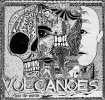
luis- Mensajes : 15681
Fecha de inscripción : 01/04/2008
 Re: Flying Nun Records/Dunedin Sound - Indie Pop MADE IN NEW ZEALAND
Re: Flying Nun Records/Dunedin Sound - Indie Pop MADE IN NEW ZEALAND
Me confirma Hamish Kilgour (The Clean) vía Facebook que tiene preparado un segundo disco en solitario que será un album doble con sonido ambiente y también que lleva 3 años trabajando en otro disco doble que publicará con su hermano David y otros músicos. Todo está pensado que salga a finales de este año o principios del que viene.
Respecto a The Clean, me confirma que en septiembre viaja a Nueva Zelanda (vive en Nueva York) y que tiene pensado reunirse con David y Robert, y que si se reúnen es muy posible que empiezen a crear nueva música y graben otro disco bajo el nombre de The Clean. Así que, cruzemos los dedos.
Sigan disfrutando del verano.
Respecto a The Clean, me confirma que en septiembre viaja a Nueva Zelanda (vive en Nueva York) y que tiene pensado reunirse con David y Robert, y que si se reúnen es muy posible que empiezen a crear nueva música y graben otro disco bajo el nombre de The Clean. Así que, cruzemos los dedos.
Sigan disfrutando del verano.

Peaky Blinder- Mensajes : 3453
Fecha de inscripción : 12/03/2010

Peaky Blinder- Mensajes : 3453
Fecha de inscripción : 12/03/2010
 Re: Flying Nun Records/Dunedin Sound - Indie Pop MADE IN NEW ZEALAND
Re: Flying Nun Records/Dunedin Sound - Indie Pop MADE IN NEW ZEALAND
https://lnwy.co/read/flying-nun-records/

Peaky Blinder- Mensajes : 3453
Fecha de inscripción : 12/03/2010

Peaky Blinder- Mensajes : 3453
Fecha de inscripción : 12/03/2010
 Re: Flying Nun Records/Dunedin Sound - Indie Pop MADE IN NEW ZEALAND
Re: Flying Nun Records/Dunedin Sound - Indie Pop MADE IN NEW ZEALAND
Acojonante el trabajo de quien hizo posible esto y las bandazas que me ha descubierto, graciassss!!!

esquío- Mensajes : 2535
Fecha de inscripción : 23/04/2013
 Re: Flying Nun Records/Dunedin Sound - Indie Pop MADE IN NEW ZEALAND
Re: Flying Nun Records/Dunedin Sound - Indie Pop MADE IN NEW ZEALAND
El de THE BATS de este año es cojonudo.
 Re: Flying Nun Records/Dunedin Sound - Indie Pop MADE IN NEW ZEALAND
Re: Flying Nun Records/Dunedin Sound - Indie Pop MADE IN NEW ZEALAND
Para mí es su mejor disco, ahí lo dejo.
cracote- Mensajes : 1568
Fecha de inscripción : 09/09/2014
 Re: Flying Nun Records/Dunedin Sound - Indie Pop MADE IN NEW ZEALAND
Re: Flying Nun Records/Dunedin Sound - Indie Pop MADE IN NEW ZEALAND
cracote escribió:Para mí es su mejor disco, ahí lo dejo.
Ojo!
 Re: Flying Nun Records/Dunedin Sound - Indie Pop MADE IN NEW ZEALAND
Re: Flying Nun Records/Dunedin Sound - Indie Pop MADE IN NEW ZEALAND
Pues no voy a ser yo quien diga lo contrario. Señor discazo!!!deniztek escribió:cracote escribió:Para mí es su mejor disco, ahí lo dejo.
Ojo!

CountryJoe- Mensajes : 11537
Fecha de inscripción : 02/08/2013
 Re: Flying Nun Records/Dunedin Sound - Indie Pop MADE IN NEW ZEALAND
Re: Flying Nun Records/Dunedin Sound - Indie Pop MADE IN NEW ZEALAND
¿inocentada o discrepas profundamente?
 Re: Flying Nun Records/Dunedin Sound - Indie Pop MADE IN NEW ZEALAND
Re: Flying Nun Records/Dunedin Sound - Indie Pop MADE IN NEW ZEALAND
jajjaja
qué juguetón hoy el administrador.
qué juguetón hoy el administrador.
 Re: Flying Nun Records/Dunedin Sound - Indie Pop MADE IN NEW ZEALAND
Re: Flying Nun Records/Dunedin Sound - Indie Pop MADE IN NEW ZEALAND
jajajaja ya te digo..... habrá que dejar los emoticonos por hoydeniztek escribió:¿inocentada o discrepas profundamente?

CountryJoe- Mensajes : 11537
Fecha de inscripción : 02/08/2013

CountryJoe- Mensajes : 11537
Fecha de inscripción : 02/08/2013

CountryJoe- Mensajes : 11537
Fecha de inscripción : 02/08/2013
 Re: Flying Nun Records/Dunedin Sound - Indie Pop MADE IN NEW ZEALAND
Re: Flying Nun Records/Dunedin Sound - Indie Pop MADE IN NEW ZEALAND
deniztek escribió:El de THE BATS de este año es cojonudo.
Maravilloso, no fue número 1 porque los Feelies lo bordaron con el In Between.

luis- Mensajes : 15681
Fecha de inscripción : 01/04/2008
 Re: Flying Nun Records/Dunedin Sound - Indie Pop MADE IN NEW ZEALAND
Re: Flying Nun Records/Dunedin Sound - Indie Pop MADE IN NEW ZEALAND
En el foro de Muzikalia había un hilo más grande que este con muchas cosas interesantes antes de que yo empezara a postear casi al final. Una pena su desaparición, cantidad de grandes bandas y canciones se perdieron con ello...

Peaky Blinder- Mensajes : 3453
Fecha de inscripción : 12/03/2010
 Re: Flying Nun Records/Dunedin Sound - Indie Pop MADE IN NEW ZEALAND
Re: Flying Nun Records/Dunedin Sound - Indie Pop MADE IN NEW ZEALAND
m b v escribió:En el foro de Muzikalia había un hilo más grande que este con muchas cosas interesantes antes de que yo empezara a postear casi al final. Una pena su desaparición, cantidad de grandes bandas y canciones se perdieron con ello...
vaya..
en su día me registré ahí aunque la verdad es que no entré mucho y no ví ese hilo..demasiados frentes

 Re: Flying Nun Records/Dunedin Sound - Indie Pop MADE IN NEW ZEALAND
Re: Flying Nun Records/Dunedin Sound - Indie Pop MADE IN NEW ZEALAND
luis escribió:deniztek escribió:El de THE BATS de este año es cojonudo.
Maravilloso, no fue número 1 porque los Feelies lo bordaron con el In Between.
yo metí el de Feelies en el top 10 y no el de los Bats (que lo redescubrí tarde)..pero creo que me gusta algo más el de los murciélagos.
salomónicamente, está bien la decisión de Cracote (Hotel Arizona) de ponerlos empatados en su top
 Re: Flying Nun Records/Dunedin Sound - Indie Pop MADE IN NEW ZEALAND
Re: Flying Nun Records/Dunedin Sound - Indie Pop MADE IN NEW ZEALAND
Pues hicimos la misma....deniztek escribió:m b v escribió:En el foro de Muzikalia había un hilo más grande que este con muchas cosas interesantes antes de que yo empezara a postear casi al final. Una pena su desaparición, cantidad de grandes bandas y canciones se perdieron con ello...
vaya..
en su día me registré ahí aunque la verdad es que no entré mucho y no ví ese hilo..demasiados frentes

CountryJoe- Mensajes : 11537
Fecha de inscripción : 02/08/2013
 Re: Flying Nun Records/Dunedin Sound - Indie Pop MADE IN NEW ZEALAND
Re: Flying Nun Records/Dunedin Sound - Indie Pop MADE IN NEW ZEALAND
CountryJoe escribió:Pues hicimos la misma....deniztek escribió:m b v escribió:En el foro de Muzikalia había un hilo más grande que este con muchas cosas interesantes antes de que yo empezara a postear casi al final. Una pena su desaparición, cantidad de grandes bandas y canciones se perdieron con ello...
vaya..
en su día me registré ahí aunque la verdad es que no entré mucho y no ví ese hilo..demasiados frentes
en el lastfm tenía algun colega que andaba por ese foro..
(grandes tiempos los del lastfm, éso sí que lo echo bastante de menos..
 Re: Flying Nun Records/Dunedin Sound - Indie Pop MADE IN NEW ZEALAND
Re: Flying Nun Records/Dunedin Sound - Indie Pop MADE IN NEW ZEALAND
Dejo éste señor disco por aquí tambien

CountryJoe- Mensajes : 11537
Fecha de inscripción : 02/08/2013
 Re: Flying Nun Records/Dunedin Sound - Indie Pop MADE IN NEW ZEALAND
Re: Flying Nun Records/Dunedin Sound - Indie Pop MADE IN NEW ZEALAND
Este de los Salad Boys es sencillamente ES-PEC-TA-CU-LAR.
cracote- Mensajes : 1568
Fecha de inscripción : 09/09/2014
 Re: Flying Nun Records/Dunedin Sound - Indie Pop MADE IN NEW ZEALAND
Re: Flying Nun Records/Dunedin Sound - Indie Pop MADE IN NEW ZEALAND
cracote escribió:Este de los Salad Boys es sencillamente ES-PEC-TA-CU-LAR.

CountryJoe- Mensajes : 11537
Fecha de inscripción : 02/08/2013
 Re: Flying Nun Records/Dunedin Sound - Indie Pop MADE IN NEW ZEALAND
Re: Flying Nun Records/Dunedin Sound - Indie Pop MADE IN NEW ZEALAND
Himno noventero desconocido..

Peaky Blinder- Mensajes : 3453
Fecha de inscripción : 12/03/2010
 Re: Flying Nun Records/Dunedin Sound - Indie Pop MADE IN NEW ZEALAND
Re: Flying Nun Records/Dunedin Sound - Indie Pop MADE IN NEW ZEALAND
Hola a todos,
Pues aquí está la sorpresa que anuncié en el topic de The Chills hace unos días.
Por una parte:
1. Anunciar que he estado trabajando muy duro durante más de un mes creando un blog al que he llamado:
DUNEDIN SOUND TAPES en el que tenéis a vuestra disposición totalmente gratis más de 300 discos -y subiendo- sobre la mejor música neozelandesa que surgió a principios de los 80. Principalmente incluyo bandas y discos del sello Flying Nun, pero después decidí incluir también de otras discográficas o cuyo sonido estuviera estrictamente ligado a lo que fue esta escena, otros sellos tan míticos como Xpressway, Meltdown o Failsafe.
Del mismo modo, hago alguna excepción, metiendo en el bote algún que otro disco los 70. Todos estos discos son de mi colección personal y los he subido todos uno a uno. Tenéis discografías enteras de los grupos más conocidos, así como de otros que a día de hoy están olvidados. A la derecha del blog tenéis un índice de etiquetas ordenado alfabéticamente por el que os podéis guiar si andáis buscando algo concreto. El 90% están a 320kbps, y el otro 10% restante en FLAC o a 192/256kbps.
Agradecería eternamente la difusión, no solo en este foro, sino en otros foros y blogs para que llegue a cuanta más gente mejor. También si alguien tiene algún pedido, que no dude en decirlo. Los próximos aportes que haga los haré más despacio porque ya los discos que quiero conseguir son imposibles en digital. Tendría que comprarlos en vinilo y luego pasarlos a digital, cosa que cuesta mucho tiempo y dinero. Por lo que espero y confío en que en los próximos meses/años aparezcan de alguna forma en la red.
http://www.dunedinsoundtapes.blogspot.com/
La segunda noticia:
2. Aún no es seguro ni sé a ciencia cierta cuándo podría culminarse, pero también estoy recopilando todo tipo de información con la intención de escribir un libro sobre este escena musical, incluyendo no solo los grupos de Flying Nun, sino de otras discográficas que dieron la oportunidad a grupos de las dos islas -norte y sur- de publicar ya fuera un EP, LP o Single durante los 80 y 90. Todo el material que estoy agrupando está en inglés, por lo que me surge la duda de si escribirlo y publicarlo en inglés o en español. Aún no lo he decidido. En cualquier caso, me lleve 1, 2 o 5 años, lo publicaré ya sea a través de una editorial -si es que existe alguien tan loco para aceptar publicar un libro sabiendo de antemano que no va a vender más de 5 o 10 copias- o autopublicándolo yo mismo.
Pues aquí está la sorpresa que anuncié en el topic de The Chills hace unos días.
Por una parte:
1. Anunciar que he estado trabajando muy duro durante más de un mes creando un blog al que he llamado:
DUNEDIN SOUND TAPES en el que tenéis a vuestra disposición totalmente gratis más de 300 discos -y subiendo- sobre la mejor música neozelandesa que surgió a principios de los 80. Principalmente incluyo bandas y discos del sello Flying Nun, pero después decidí incluir también de otras discográficas o cuyo sonido estuviera estrictamente ligado a lo que fue esta escena, otros sellos tan míticos como Xpressway, Meltdown o Failsafe.
Del mismo modo, hago alguna excepción, metiendo en el bote algún que otro disco los 70. Todos estos discos son de mi colección personal y los he subido todos uno a uno. Tenéis discografías enteras de los grupos más conocidos, así como de otros que a día de hoy están olvidados. A la derecha del blog tenéis un índice de etiquetas ordenado alfabéticamente por el que os podéis guiar si andáis buscando algo concreto. El 90% están a 320kbps, y el otro 10% restante en FLAC o a 192/256kbps.
Agradecería eternamente la difusión, no solo en este foro, sino en otros foros y blogs para que llegue a cuanta más gente mejor. También si alguien tiene algún pedido, que no dude en decirlo. Los próximos aportes que haga los haré más despacio porque ya los discos que quiero conseguir son imposibles en digital. Tendría que comprarlos en vinilo y luego pasarlos a digital, cosa que cuesta mucho tiempo y dinero. Por lo que espero y confío en que en los próximos meses/años aparezcan de alguna forma en la red.
http://www.dunedinsoundtapes.blogspot.com/
La segunda noticia:
2. Aún no es seguro ni sé a ciencia cierta cuándo podría culminarse, pero también estoy recopilando todo tipo de información con la intención de escribir un libro sobre este escena musical, incluyendo no solo los grupos de Flying Nun, sino de otras discográficas que dieron la oportunidad a grupos de las dos islas -norte y sur- de publicar ya fuera un EP, LP o Single durante los 80 y 90. Todo el material que estoy agrupando está en inglés, por lo que me surge la duda de si escribirlo y publicarlo en inglés o en español. Aún no lo he decidido. En cualquier caso, me lleve 1, 2 o 5 años, lo publicaré ya sea a través de una editorial -si es que existe alguien tan loco para aceptar publicar un libro sabiendo de antemano que no va a vender más de 5 o 10 copias- o autopublicándolo yo mismo.

Peaky Blinder- Mensajes : 3453
Fecha de inscripción : 12/03/2010
 Re: Flying Nun Records/Dunedin Sound - Indie Pop MADE IN NEW ZEALAND
Re: Flying Nun Records/Dunedin Sound - Indie Pop MADE IN NEW ZEALAND
Joder, realmente espectacular... Eres un crack, macho.
Lo seguiremos con atención.
Mucha suerte con los proyectos.

Lo seguiremos con atención.
Mucha suerte con los proyectos.


luis- Mensajes : 15681
Fecha de inscripción : 01/04/2008
 Re: Flying Nun Records/Dunedin Sound - Indie Pop MADE IN NEW ZEALAND
Re: Flying Nun Records/Dunedin Sound - Indie Pop MADE IN NEW ZEALAND
luis escribió:Joder, realmente espectacular... Eres un crack, macho.
Lo seguiremos con atención.
Mucha suerte con los proyectos.

Sombrerazo.
 Re: Flying Nun Records/Dunedin Sound - Indie Pop MADE IN NEW ZEALAND
Re: Flying Nun Records/Dunedin Sound - Indie Pop MADE IN NEW ZEALAND
Y ahora a darle un buen vistazo al blog!
(que, no cabe ni decirlo, va de cabeza a favoritos)
(que, no cabe ni decirlo, va de cabeza a favoritos)
Página 6 de 11. •  1, 2, 3 ... 5, 6, 7 ... 9, 10, 11
1, 2, 3 ... 5, 6, 7 ... 9, 10, 11 
 Temas similares
Temas similares» INTRODUCCIÓN AL DUNEDIN SOUND - Guía para principiantes
» HOTEL ARIZONA especial 40 años de Flying Nun Records
» HOTEL ARIZONA especial Red Bird Records (y Blue Cat Records)
» WORLD MAGNETIC - AUSTRALIA/NEW ZEALAND/JAPN 2010
» who made who????
» HOTEL ARIZONA especial 40 años de Flying Nun Records
» HOTEL ARIZONA especial Red Bird Records (y Blue Cat Records)
» WORLD MAGNETIC - AUSTRALIA/NEW ZEALAND/JAPN 2010
» who made who????
Página 6 de 11.
Permisos de este foro:
No puedes responder a temas en este foro.
 Índice
Índice